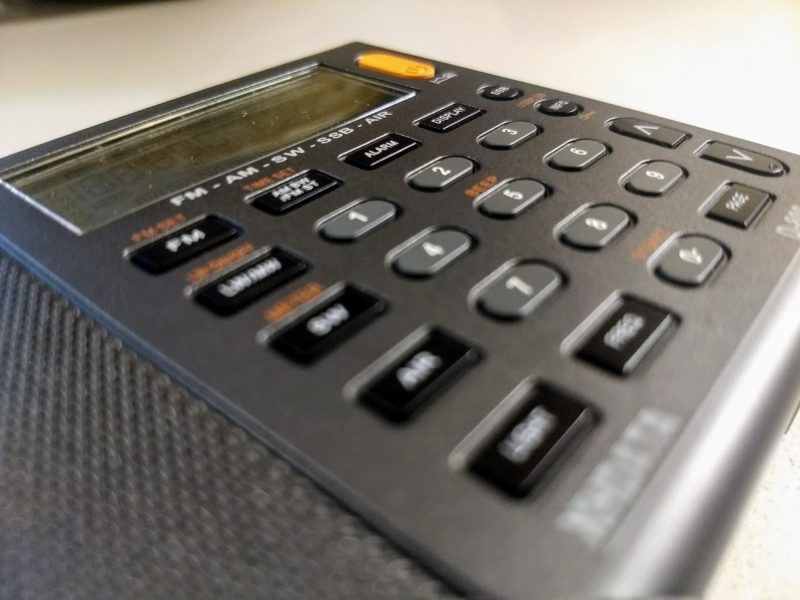 Many thanks to SWLing Post contributor, Gary DeBock, who shares his extensive 2021 Ultralight Radio Shootout.
Many thanks to SWLing Post contributor, Gary DeBock, who shares his extensive 2021 Ultralight Radio Shootout.
This is truly a deep dive featuring five popular ultralight portable radios and examining mediumwave, shortwave, FM, and AIR Band performance.
The review is an amazing 40 pages long! In order to display the entire review, click on the “Continue reading” link below.
2021 Ultralight Radio Shootout
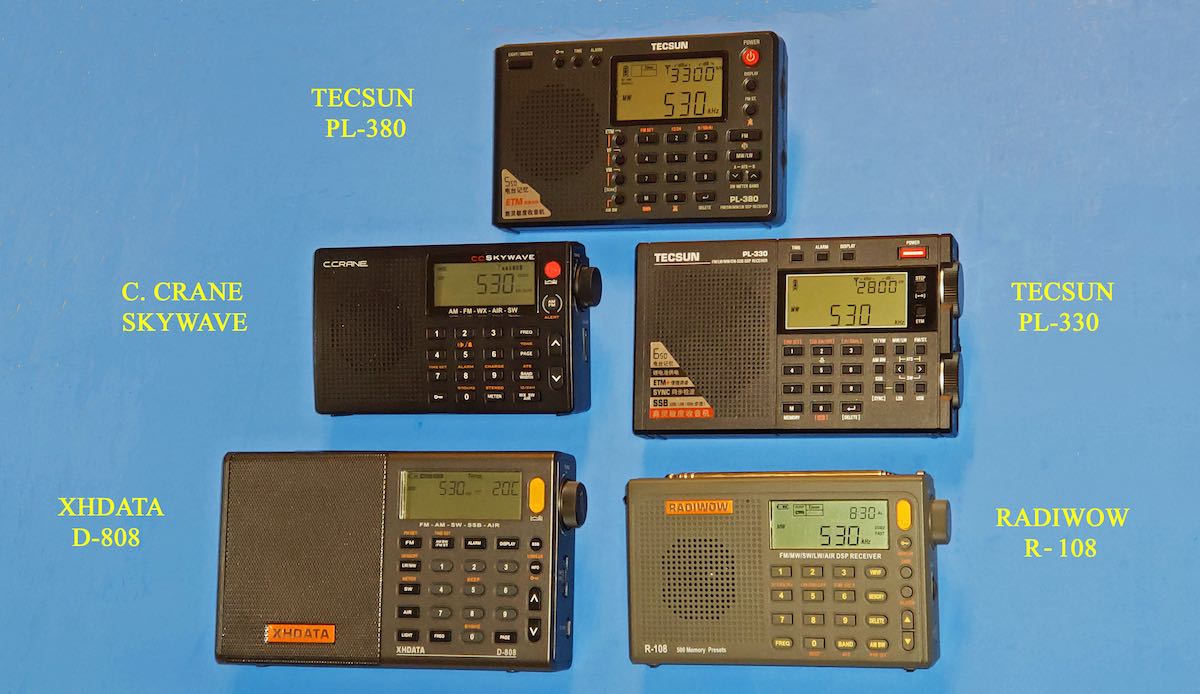
Five Hot Little Portables Brighten Up the Pandemic
By Gary DeBock, Puyallup, WA, USA April 2021
Introduction The challenges and thrills of DXing with pocket radios have not only survived but thrived since the Ultralight Radio Boom in early 2008, resulting in a worldwide spread of the hobby niche group. Based upon the essential concepts of DXing skill, propagation knowledge and perseverance, the human factor is critical for success in pocket radio DXing, unlike with computer-controlled listening. The hobbyist either sinks or swims according to his own personal choices of DXing times, frequencies and recording decisions during limited propagation openings—all with the added challenge of depending on very basic equipment. DXing success or failure has never been more personal… but on the rare occasions when legendary DX is tracked down despite all of the multiple challenges, the thrill of success is truly exceptional—and based entirely upon one’s own DXing skill.
Ultralight Radio DXing has inspired spinoff fascination not only with portable antennas like the new Ferrite Sleeve Loops (FSL’s) but also with overseas travel DXing, enhanced transoceanic propagation at challenging sites like ocean side cliffs and Alaskan snowfields, as well as at isolated islands far out into the ocean. The extreme portability of advanced pocket radios and FSL antennas has truly allowed hobbyists to “go where no DXer has gone before,” experiencing breakthrough radio propagation, astonishing antenna performance and unforgettable hobby thrills. Among the radio hobby groups of 2021 it is continuing to be one of the most innovative and vibrant segments of the entire community.
The portable radio manufacturing industry has changed pretty dramatically over the past few years as much of the advanced technology used by foreign companies in their radio factories in China has been “appropriated” (to use a generous term) by new Chinese competitors. Without getting into the political ramifications of such behavior the obvious fact in the 2021 portable radio market is that all of the top competitors in this Shootout come from factories in China, and four of the five have Chinese name brands. For those who feel uneasy about this rampant copying of foreign technology the American-designed C. Crane Skywave is still available, although even it is still manufactured in Shenzhen, China—the nerve center of such copying.
Prior to purchasing any of these portables a DXer should assess his own hobby goals, especially whether transoceanic DXing will be part of the mission– in which case a full range of DSP filtering options is essential. Two of the China-brand models use only rechargeable 3.7v lithium type batteries with limited run time, which may not be a good choice for DXers who need long endurance out in the field. A hobbyist should also decide whether a strong manufacturer’s warranty is important. Quality control in some Chinese factories has been lacking, and some of the China-brand radio sellers offer only exchanges—after you pay to ship the defective model back to China. Purchasers should not assume that Western concepts of reliability and refunds apply in China, because in many cases they do not. When purchasing these radios a DXer should try to purchase through a reputable seller offering a meaningful warranty—preferably in their own home country.
One of the unique advantages of Ultralight Radio DXing is the opportunity to sample the latest in innovative technology at a very reasonable cost—and the five pocket radio models chosen for this review include some second-generation DSP chip models with astonishing capabilities. Whether your interest is in domestic or split-frequency AM-DXing, FM, Longwave or Shortwave, the pocket radio manufacturers have designed a breakthrough model for you—and you can try out any (or all) of them at a cost far less than that of a single table receiver. So get ready for some exciting introductions… and an even more exciting four band DXing competition!
SECTION ONE: MEET THE CONTESTANTS
 XHDATA D-808
XHDATA D-808
Although the size of this AM-FM-SW-LW-AIR portable clearly exceeds the 20 cubic inch limit necessary for “official” Ultralight Radio designation, the model’s performance and popularity have definitely earned it a place in this major pocket radio review. “Inspired” (to use a generous term) by the introduction of C. Crane’s breakthrough Skywave SSB model at the same Shenzhen, China location a few months earlier, the Chinese startup company essentially had the chance to benefit from C. Crane’s substantial R&D costs, copy all of the Skywave SSB’s strong points and improve upon its weak points—including the $169.99 price. The end result is a very competitive DXing radio with a current reputation for high quality—despite a warranty policy which has changed repeatedly, and originally was non-existent. In many parts of the world this has become the premier portable radio for DXing purposes.
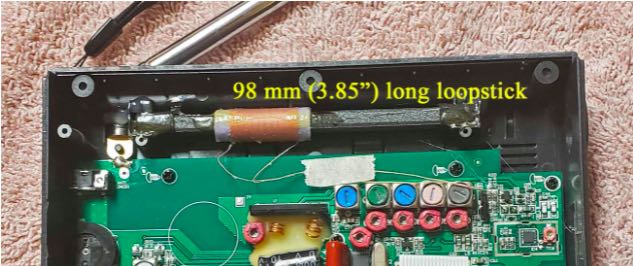 This versatile radio features coverage of Longwave (150-450 kHz), AM (520-1710 kHz), FM (64-108 MHz), Shortwave (1711-29,999 kHz) and AIR band (118-137 MHz). It is powered by a 3.7 volt “18650” lithium battery with a reputation for generous run time (or a 5 volt DC adapter, which is not included), and has a 70mm (2.75”) speaker with relatively powerful 1 watt output—although not rated as highly as the surprising 3 watt speaker rating of its smaller Radiwow R-108 sibling. Both the relatively large speaker and the 98mm (3.85”) length of the loopstick antenna are directly related to the generous cabinet size, which at 152mm x 92mm x 32mm (6” long x 3.6” high x 1.26” wide) is clearly outside of the “official” Ultralight size limit of 20 cubic inches (at 27.2 cubic inches). As such, the D-808 model is included in this review primarily for reference purposes, since all of the other contestants do qualify as compact pocket radios within the size limit.
This versatile radio features coverage of Longwave (150-450 kHz), AM (520-1710 kHz), FM (64-108 MHz), Shortwave (1711-29,999 kHz) and AIR band (118-137 MHz). It is powered by a 3.7 volt “18650” lithium battery with a reputation for generous run time (or a 5 volt DC adapter, which is not included), and has a 70mm (2.75”) speaker with relatively powerful 1 watt output—although not rated as highly as the surprising 3 watt speaker rating of its smaller Radiwow R-108 sibling. Both the relatively large speaker and the 98mm (3.85”) length of the loopstick antenna are directly related to the generous cabinet size, which at 152mm x 92mm x 32mm (6” long x 3.6” high x 1.26” wide) is clearly outside of the “official” Ultralight size limit of 20 cubic inches (at 27.2 cubic inches). As such, the D-808 model is included in this review primarily for reference purposes, since all of the other contestants do qualify as compact pocket radios within the size limit.
The larger size and weight (265g, or 5.8 ounces, without battery) do somewhat detract from its appeal as a travel portable in comparison to a lightweight competitive model like the C. Crane Skywave– but this size does provide advantages not only in speaker size and loopstick length but in the ease of disassembly and maintenance (or modification, such as loopstick transplants). Included in the D-808 package is a matched-size travel bag, 3m (9.8’) plug-in antenna for FM, Shortwave and AIR (there is a jack for this on the cabinet’s left side), a USB charge cable, a company name “18650” 3.7 volt lithium battery and a very basic (and tiny) 10-page English manual written in mouse-type font. Completely absent in the manual is any mention of a warranty, and although this model has a current reputation of high quality, you should definitely investigate your seller’s policy of return or refund prior to making a purchase. More than any other portable in this review the pricing of the XHDATA D-808 is “all over the map,” with the current low price of $100.98 (including free shipping to the USA) offered by the eBay seller “Liulituan2014.” On the other hand some eBay sellers in China and Japan are asking up to $276.99 for the exact same model– so beware of price gouging. Shortly after its development the D-808 was extensively reviewed as part of a 7.5 inch loopstick transplant article (for both MW and Longwave), which is posted at https://dreamcrafts.box.com/s/5d0pi85jfptgmrj4pd0jsmaybgb6gteh
After initial development XHDATA did not allow shipments of the D-808 to North America, apparently trying to avoid a copyright lawsuit from C. Crane, from whose Skywave SSB model much of its technology was copied. The American-designed Si4735 DSP chip provides varied capabilities and high reliability, and although the Skywave has a dedicated DSP chip for the AIR and Weather Bands, XHDATA has managed to boost up AIR band performance past that of the Skywave. The SSB tuning system closely matches that of the Skywave SSB, and like the Skywave it can also scan and store radio stations on any band with the Auto Tuning System (ATS). The D-808 can store up to 500 stations in memory, with 100 frequencies, bandwidth selections (AM, LW, Shortwave and AIR only) or stereo-mono selection (FM only) available for each band. The multi-function digital display can indicate time, alarm time, signal strength/RSSI or temperature (selectable between F or C). The model has a selectable display light– although one very common complaint is that the light is far too strong at night, dazzling the operator who is attempting to view the display.
Over a two year period the author has purchased and disassembled 12 of these models for loopstick transplant purposes, and the quality control record from the factory has been very good, despite a nebulous (or non-existent) a warranty policy. There is no guarantee that this high Q/C standard will continue indefinitely, though, so purchasers should always investigate the return and refund policy of their chosen seller, and if possible, purchase within their home country from a reputable seller. As for your options if you purchase a defective model straight from China, you will need to depend on XHDATA’s constantly changing “Service Guarantee,” which is posted on their website for all XHDATA/Radiwow/Sihuadon models. Unlike the Sony company in the 70’s and 80’s XHDATA has no authorized service centers in North America, so you are required to ship the defective model back to China before the company will consider a replacement—a very unfavorable option!
XHDATA D-808—MW-DXing Test Drive
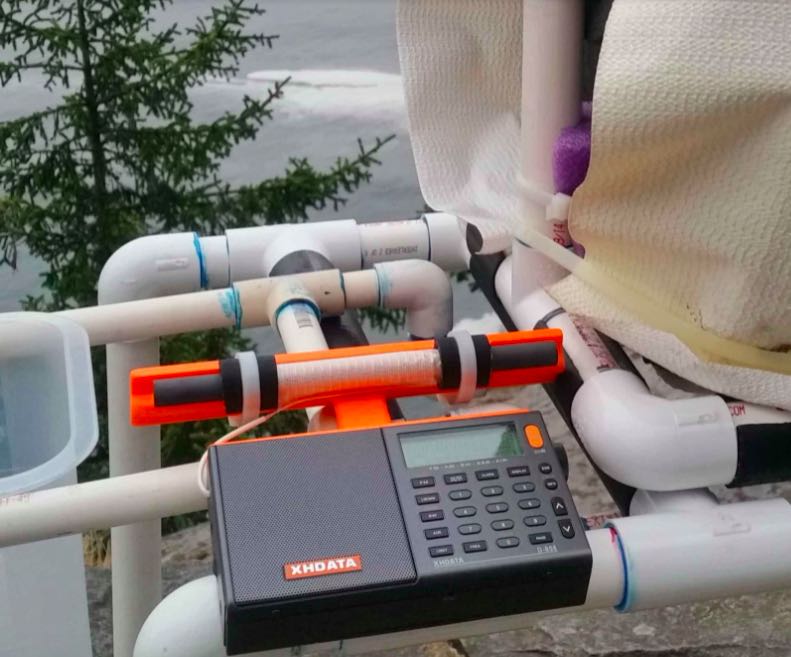 Although the 98mm (3.85”) loopstick length of this non-Ultralight portable provides an unfair advantage in sensitivity over the smaller contestants in this Shootout the D-808 has other strong points which combine to make a very competitive DXing package. The Silicon Labs’ Si4735 DSP chip provides excellent MW performance without the common digital quirks plaguing both the Radiwow R-108 sibling and the Tecsun PL-380, and the audio quality and power is excellent for a medium-sized portable. The multiple tuning options, DSP filtering choices and 100 memories (for the MW band) provide good versatility for almost all DXing situations, and the radio’s solid, high quality construction is a bonus for rough venues like ocean side cliffs and isolated tropical islands. I have used a couple of D-808’s (along with a couple of CC Skywaves) in wild ocean cliff DXpeditions over a period of two years, constantly testing their ability to survive extreme weather and travel bumps—and the radios are still kicking. Although the manual will not tell you this, the radio can usually survive a major rain drenching without issue if you wipe the cabinet dry about once an hour. The stock XHDATA “18650” 3.7 volt lithium battery has generous run time, and can be easily replaced by premium-design batteries if even longer run time is desired. The most common D-808 customer complaint seems to concern the display lighting, which is so overpowering in darkness that the user is temporarily dazzled– rendering the display illegible. This has indeed been a problem for me during predawn DXing on ocean cliffs, and because of this I try to avoid any changes to a D-808 setup prior to dawn, and only use these portables for “set and forget” recording on selected frequencies prior to sunrise.
Although the 98mm (3.85”) loopstick length of this non-Ultralight portable provides an unfair advantage in sensitivity over the smaller contestants in this Shootout the D-808 has other strong points which combine to make a very competitive DXing package. The Silicon Labs’ Si4735 DSP chip provides excellent MW performance without the common digital quirks plaguing both the Radiwow R-108 sibling and the Tecsun PL-380, and the audio quality and power is excellent for a medium-sized portable. The multiple tuning options, DSP filtering choices and 100 memories (for the MW band) provide good versatility for almost all DXing situations, and the radio’s solid, high quality construction is a bonus for rough venues like ocean side cliffs and isolated tropical islands. I have used a couple of D-808’s (along with a couple of CC Skywaves) in wild ocean cliff DXpeditions over a period of two years, constantly testing their ability to survive extreme weather and travel bumps—and the radios are still kicking. Although the manual will not tell you this, the radio can usually survive a major rain drenching without issue if you wipe the cabinet dry about once an hour. The stock XHDATA “18650” 3.7 volt lithium battery has generous run time, and can be easily replaced by premium-design batteries if even longer run time is desired. The most common D-808 customer complaint seems to concern the display lighting, which is so overpowering in darkness that the user is temporarily dazzled– rendering the display illegible. This has indeed been a problem for me during predawn DXing on ocean cliffs, and because of this I try to avoid any changes to a D-808 setup prior to dawn, and only use these portables for “set and forget” recording on selected frequencies prior to sunrise.
As mentioned previously this model has a wide-open circuit board design ideal for loopstick transplants, including Longwave-optimized loopsticks. Unlike its R-108 sibling the radio is engineered for reliable disassembly and reassembly, making such modifications routine for any hobbyist with related experience. Installation of either the enhanced MW or Longwave loopstick greatly improves sensitivity on the chosen band, and transforms the model into a thrilling travel DXing portable. Several local DXers like Walt and Bruce have taken these modified D-808 portables on transoceanic vacations, sampling fascinating propagation unavailable in North America.
XHDATA D-808—FM-DXing Test Drive
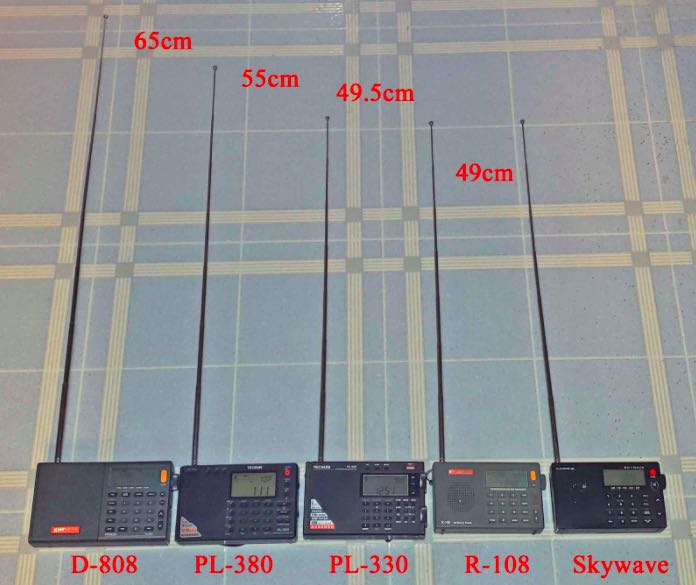 Although all of these models come with a plug-in antenna for FM and Shortwave the stock whip antenna of the D-808 is clearly the Shootout class leader in length, extending to 65.4cm (25.75”). In combination with the quality performance of the Si4735 DSP chip and the relatively powerful, high quality audio the whip antenna can receive plenty of marginal FM signals, providing a lot of DXing capability even in noisy locations. Unique among these Shootout contestants the radio does have RDS capability, although the mouse print manual will tell you nothing about this. When certain strong stations are received the RDS will display the programming format, but nothing else. The D-808’s plug-in antenna for FM, Shortwave and the AIR band is the same 3m (9.1”) type supplied with the R-108, and depending upon how you raise and orient the wire, weak station reception can often be improved over that of the whip antenna. The 64-108 MHz coverage provides worldwide FM reception capability (exceeding the 76-108 MHz coverage of the Skywave), and like its R-108 sibling the D-808 features powerful 1 watt audio from a high quality speaker. In contrast to the R-108, however, this model also has a powerful “18650” lithium battery with generous run time– so that a listener can enjoy some powerful audio for quite a while. Having the volume control on the opposite side of the radio from the tuning control is a little awkward, but this is a minor point. Not so minor is the dazzling display light on the D-808 (as described in the Medium Wave Test Drive), making it tough to read the display or control buttons in dark situations. For those who chase DX outdoors at night, this could be termed a glaring oversight.
Although all of these models come with a plug-in antenna for FM and Shortwave the stock whip antenna of the D-808 is clearly the Shootout class leader in length, extending to 65.4cm (25.75”). In combination with the quality performance of the Si4735 DSP chip and the relatively powerful, high quality audio the whip antenna can receive plenty of marginal FM signals, providing a lot of DXing capability even in noisy locations. Unique among these Shootout contestants the radio does have RDS capability, although the mouse print manual will tell you nothing about this. When certain strong stations are received the RDS will display the programming format, but nothing else. The D-808’s plug-in antenna for FM, Shortwave and the AIR band is the same 3m (9.1”) type supplied with the R-108, and depending upon how you raise and orient the wire, weak station reception can often be improved over that of the whip antenna. The 64-108 MHz coverage provides worldwide FM reception capability (exceeding the 76-108 MHz coverage of the Skywave), and like its R-108 sibling the D-808 features powerful 1 watt audio from a high quality speaker. In contrast to the R-108, however, this model also has a powerful “18650” lithium battery with generous run time– so that a listener can enjoy some powerful audio for quite a while. Having the volume control on the opposite side of the radio from the tuning control is a little awkward, but this is a minor point. Not so minor is the dazzling display light on the D-808 (as described in the Medium Wave Test Drive), making it tough to read the display or control buttons in dark situations. For those who chase DX outdoors at night, this could be termed a glaring oversight.
Shortwave and Air Band Function
The D-808’s relatively long whip antenna, multiple DSP filter options, SSB capability and wide Shortwave coverage (1711-29,999 kHz) provide a lot of advantages in tracking down the dwindling number of international broadcast stations as well as amateur radio communication. The SSB system is practically identical to that of the Skywave SSB (featuring C. Crane’s original breakthrough design) with selectable LSB, USB and a fine tuning thumbwheel (as opposed to the Skywave SSB’s switched-on fine tuning using the main tuning knob). One difference is that on the D-808 you need to short press the “Lock” button to toggle between LSB and USB– a rather odd feature. Fine tuning of amateur radio SSB signals was easy with this system, although you will need to know which sideband to choose for each band of frequencies. The mouse print manual says there are 6 DSP filter options on AM, SW, LW and AIR, but in fact there are 7 (which are 6 kHz, 4 kHz, 3 kHz, 2.5 kHz, 2 kHz, 1.8 kHz and 1 kHz). Oddly enough the manual says almost nothing about the SSB system and function, only advising the operator to use the fine tuning control to tune in a station– a stark contrast with the Skywave SSB’s detailed instructions. The D-808 has 6 DSP filtering options on SSB (4 kHz, 3 kHz, 2.2 kHz, 1.2 kHz, 1 kHz and 500 Hz), and although it lacks the Skywave SSB’s red LED indicator for SSB function, the two systems function in an identical manner. Either radio should provide good SSB reception of strong stations, but once again the XHDATA’s longer whip antenna, superior speaker and audio strength excel in noisy outdoor locations.
The D-808 includes coverage of the 118-137 MHz AIR band, and in a surprise during testing against the C. Crane Skywave it managed slightly superior reception of the local Seattle-Tacoma airport tower communication on 119.900 MHz. Once again the mouse print manual says almost nothing about the AIR band function, except to press the AIR button to activate coverage, and hold the button down for an ATS scan. This is in contrast to the Skywave manual, which provides detailed instructions, including a link for airport control frequencies in North America. My mouse print manual says nothing about a Squelch capability for the D-808, but in fact the model does have such a function, which is activated by long pressing the Tuning knob, and waiting for the “Squelch” readout to show up at the bottom of the display. While still pressing in the Tuning knob you can adjust the Squelch level by turning the Tuning knob clockwise to raise the squelch level from 1 to 9. Although this Squelch function is available on all bands on the D-808 it is apparently useful only on the AIR band (Thanks to Satoshi Miyauchi for this Squelch-related information).
In the AIR mode the 6 DSP filter options are the same as those provided on AM and Shortwave, and in an environment with several strong transmitters the ATS function should be able to track down a few stations. AIR band transmissions are usually brief and businesslike, however, so the ATS may skip over several local frequencies if there was no transmission at the time of the scan.
Other Resources
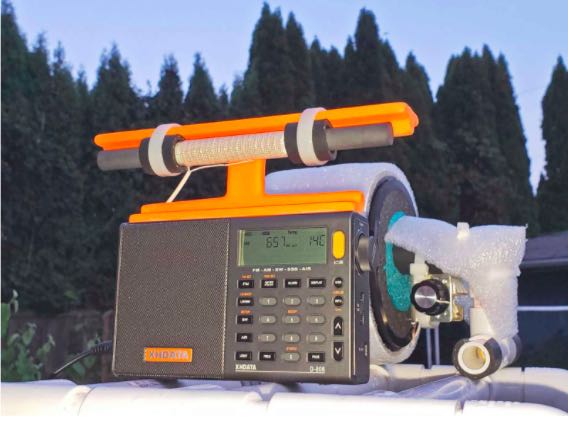 Supercharging the XHDATA D-808—Installation of Enhanced MW and Longwave Loopsticks https://dreamcrafts.box.com/s/5d0pi85jfptgmrj4pd0jsmaybgb6gteh
Supercharging the XHDATA D-808—Installation of Enhanced MW and Longwave Loopsticks https://dreamcrafts.box.com/s/5d0pi85jfptgmrj4pd0jsmaybgb6gteh
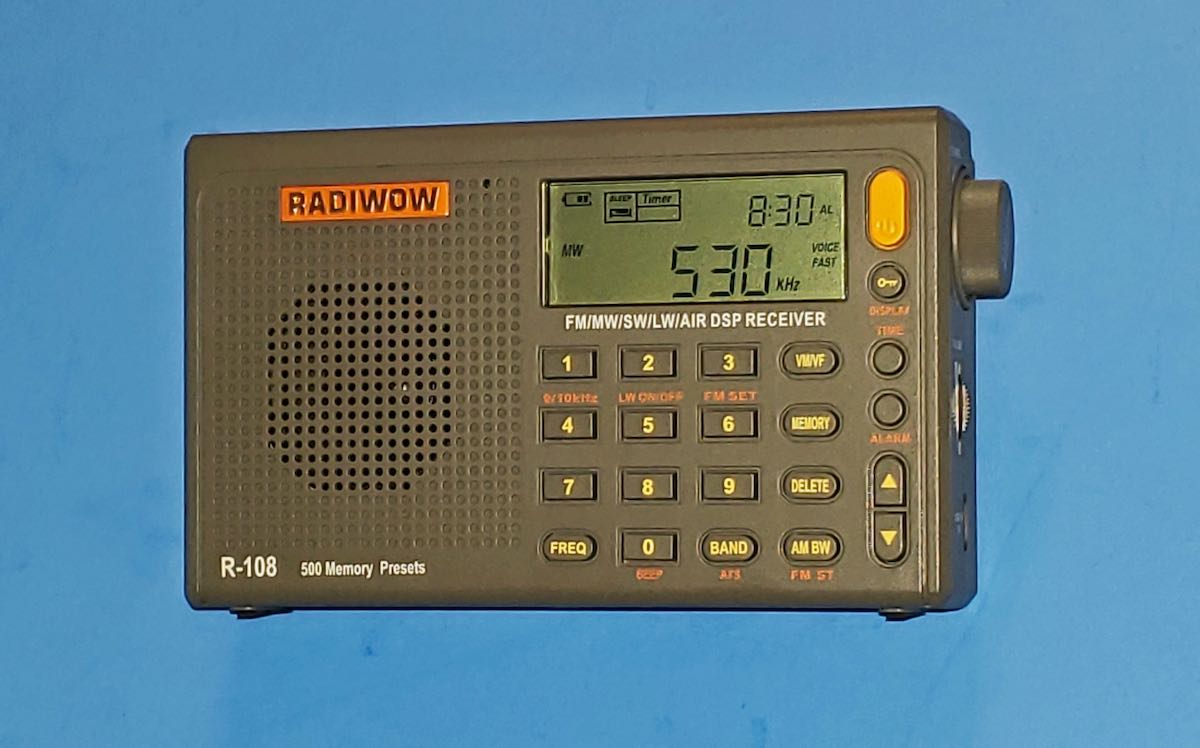
RADIWOW R-108
China’s XHDATA company offers a smaller and less expensive pocket radio than their D-808 model, with the length, height, width, whip antenna and loopstick all directly copied from the C. Crane Skywave model. This is the R-108– an AM-FM-SW-LW-AIR portable coming in two colors: a dark grey version under the “Radiwow” name, and a black version (matching the CC Skywave color) under the “Sihuadon” name. Both models are completely identical in function, and both are manufactured by the same XHDATA company that makes the D-808.
The functions of the R-108 are basically similar to those of the larger D-808, but there is no SSB capability, and the model lacks the D-808’s high quality Si4735 DSP chip (and as a result, some of the larger model’s reliability, and freedom from digital quirks on MW). Despite some rough edges the radio offers fairly competitive performance for casual DXers looking for unusually good FM reception and great speaker audio– who don’t want to pay more than around $50 US. As such, its place in the 2021 pocket radio market is similar to that of the Tecsun PL-380 and PL-310ET, a couple of other China brand portables with their own MW digital quirks. Like the larger D-808 this model features coverage of Longwave (150-450 kHz), AM (520-1710 kHz), FM (64-108 MHz), Shortwave (1711-29,999 kHz) and AIR band (118-137 MHz). It is powered by a relatively wimpy “BL-5C” 3.7 volt lithium battery (commonly used in cell phones, and also in the Tecsun PL-330) with variable performance—with some company batteries having a tendency to bail after a few hours of heavy usage. The model has the Auto Tuning System to scan and store stations, as well as 500 memories available (100 for each band). Included in the R-108 package is the radio, a 3m (9.1”) external plug-in antenna for FM, SW and AIR, a USB charge cable, a company-name “BL-5C” lithium battery (except in the black Sihuadon model, which has a generic, no-name battery) and surprisingly, a 23-page English manual which is larger, far more detailed and with larger font than that of its more expensive D-808 sibling. Despite this 23-page operating manual there is still no mention of any type of warranty offered by Radiwow or Sihuadon on the R-108 model, though—just like the lack of one in the D-808 manual.
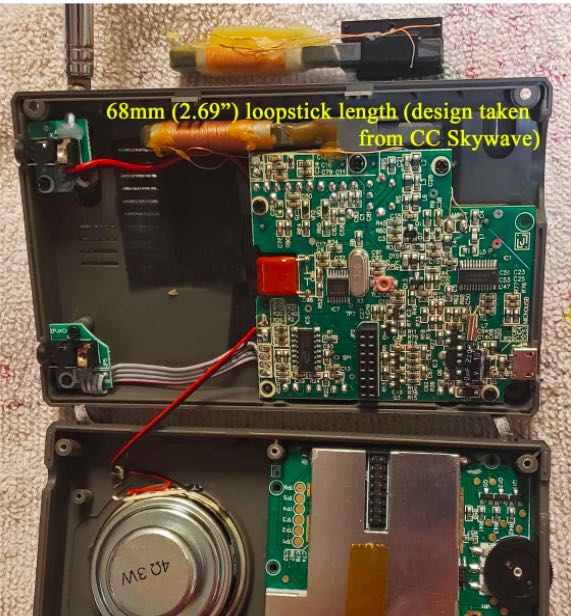 In one impressive feature the R-108 is clearly the Ultralight class leader, however—it has a powerful 3 watt speaker (NOT 5 watts, as claimed both in advertising and the owner’s manual). This unusually robust speaker has a thick plastic enclosure (removed in the photo to the left) to direct the audio outside the cabinet—an arrangement which provides exceptional audio quality and strength for the small cabinet size. The rated audio output is 1 watt at 10% distortion, but unfortunately running such powerful speaker audio for extended periods will likely exhaust the rather wimpy BL-5C (3.7 volt) lithium battery prematurely.
In one impressive feature the R-108 is clearly the Ultralight class leader, however—it has a powerful 3 watt speaker (NOT 5 watts, as claimed both in advertising and the owner’s manual). This unusually robust speaker has a thick plastic enclosure (removed in the photo to the left) to direct the audio outside the cabinet—an arrangement which provides exceptional audio quality and strength for the small cabinet size. The rated audio output is 1 watt at 10% distortion, but unfortunately running such powerful speaker audio for extended periods will likely exhaust the rather wimpy BL-5C (3.7 volt) lithium battery prematurely.
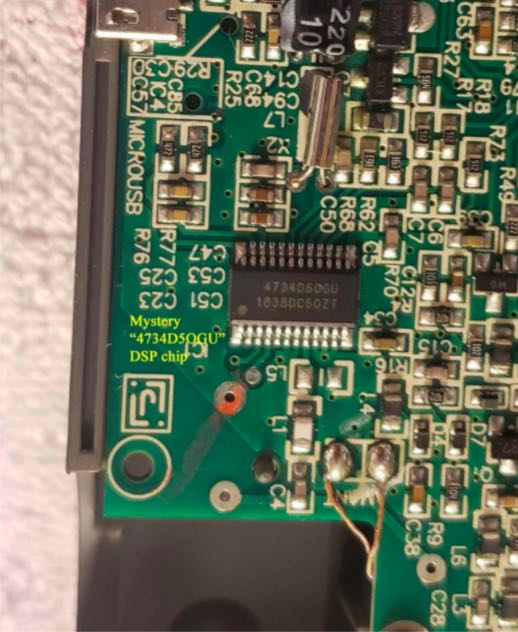 As mentioned previously this model is subject to MW digital quirks– although most of them could probably be tolerated if a purchaser isn’t an all-out DXer insistent on top quality. Out of 9 Radiwow R-108 test models 7 of them suffered from a strange buzzing noise as the volume control was increased or decreased, especially on the high MW band. Four of the test models broke into intermittent loud oscillations on high MW frequencies like 1650 and 1670 kHz, making it impossible to continue listening on those frequencies. There is an internal “4734D5OGU” DSP chip on the RF board (unshielded) which is certainly NOT a Silicon Labs’ Si4734 DSP chip, but may be a Chinese copy of it—and possibly the source of the digital quirks (see photo on next page). In addition the construction quality seems a step down from that of the XHDATA D-808, with self-tapping screws used exclusively (as opposed to the D-808’s threaded screws), and lacking the larger model’s ease of disassembly and reassembly. Since most of my Radiwow test models were purchased from Chinese eBay sellers when the R-108 was first marketed there was no possibility of any warranty, returns or refunds—so learn from my experience, and before considering a purchase of this R-108 model make every effort to track down a reputable seller in your home country, who is willing to back up the quality of the radio you are ordering. Unlike the D-808 (with prices all over the map) the R-108 is almost always offered at a price around $50.
As mentioned previously this model is subject to MW digital quirks– although most of them could probably be tolerated if a purchaser isn’t an all-out DXer insistent on top quality. Out of 9 Radiwow R-108 test models 7 of them suffered from a strange buzzing noise as the volume control was increased or decreased, especially on the high MW band. Four of the test models broke into intermittent loud oscillations on high MW frequencies like 1650 and 1670 kHz, making it impossible to continue listening on those frequencies. There is an internal “4734D5OGU” DSP chip on the RF board (unshielded) which is certainly NOT a Silicon Labs’ Si4734 DSP chip, but may be a Chinese copy of it—and possibly the source of the digital quirks (see photo on next page). In addition the construction quality seems a step down from that of the XHDATA D-808, with self-tapping screws used exclusively (as opposed to the D-808’s threaded screws), and lacking the larger model’s ease of disassembly and reassembly. Since most of my Radiwow test models were purchased from Chinese eBay sellers when the R-108 was first marketed there was no possibility of any warranty, returns or refunds—so learn from my experience, and before considering a purchase of this R-108 model make every effort to track down a reputable seller in your home country, who is willing to back up the quality of the radio you are ordering. Unlike the D-808 (with prices all over the map) the R-108 is almost always offered at a price around $50.
The Radiwow “business model” for these portables seems to concentrate on superior FM and AIR band performance, great audio fidelity, multiple functions and a low price—hopefully avoiding repair expenses for customer complaints about the minor digital quirks. The dodgy company “warranty” confirms this assessment.
Radiwow R-108—MW-DXing Test Drive
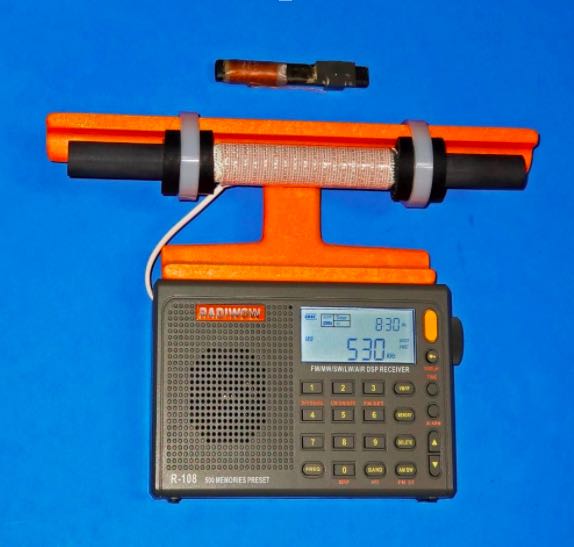 Out in the field the R-108’s relatively high quality audio through the speaker is a definite plus when receiving fairly strong stations, although MW-DXers typically place more value on high sensitivity and effective DSP selectivity than audio quality. Since the height, length, width and loopstick of this Chinese factory model were all copied directly from C. Crane’s Skywave it is most interesting to compare these two models in a DXing “test drive,” and notice the differences in their performance. Low and high band sensitivity are similar on both models but the R-108’s 1 kHz DSP filter audio is significantly more “muffled” than that of the Skywave, with most of the high audio frequencies cut off. Advancing the R-108’s volume control on my brand new Sihuadon model (purchased last month) results in a buzzing/ twisting noise during reception of weak MW stations (most noticeable on the high band), a quirk affecting most of my R-108 test models. None of these issues affect the CC Skywave, but at half the price of the Skywave the R-108 does deliver fairly competitive performance despite the quirks. The speaker audio is well balanced and powerful, with bass response in a different league than that of the C.Crane model (with its 1.5”/ 38mm) speaker and 500 mw output). When chasing weak MW targets the powerful audio output of the R-108 seldom comes into play, though, because limited sensitivity forces the user to max out the volume control long before serious audio power comes through the speaker. The audio amps of the CC Skywave, Tecsun PL-330 and Tecsun PL-380 all deliver much stronger audio on extremely weak MW targets than the R-108, although these other models typically throw in some distortion as part of the process. As such, in chasing weak MW targets you have the R-108’s high quality speaker not used to its full potential, while the other models will usually deliver all the audio you want but overdrive their modest speakers. Plugging headphones into the R-108 in an attempt to boost up the audio on weak MW targets will not correct this problem, and the DXer finally needs to accept the fact that this model’s design limits its capability to dig out extremely weak MW stations—something that the other four contestants in this Shootout can accomplish quite well. How did this happen? Well, early model CC Skywave models also came with a relatively wimpy audio amp (as reported in the 2015 Shootout article) and Radiwow no doubt copied much of the Skywave’s circuitry. C.Crane has obviously boosted up the Skywave’s audio amp power in recent firmware revisions, but Radiwow has apparently been left in the lurch with the R-108 circuitry copied from the original Skywave model.
Out in the field the R-108’s relatively high quality audio through the speaker is a definite plus when receiving fairly strong stations, although MW-DXers typically place more value on high sensitivity and effective DSP selectivity than audio quality. Since the height, length, width and loopstick of this Chinese factory model were all copied directly from C. Crane’s Skywave it is most interesting to compare these two models in a DXing “test drive,” and notice the differences in their performance. Low and high band sensitivity are similar on both models but the R-108’s 1 kHz DSP filter audio is significantly more “muffled” than that of the Skywave, with most of the high audio frequencies cut off. Advancing the R-108’s volume control on my brand new Sihuadon model (purchased last month) results in a buzzing/ twisting noise during reception of weak MW stations (most noticeable on the high band), a quirk affecting most of my R-108 test models. None of these issues affect the CC Skywave, but at half the price of the Skywave the R-108 does deliver fairly competitive performance despite the quirks. The speaker audio is well balanced and powerful, with bass response in a different league than that of the C.Crane model (with its 1.5”/ 38mm) speaker and 500 mw output). When chasing weak MW targets the powerful audio output of the R-108 seldom comes into play, though, because limited sensitivity forces the user to max out the volume control long before serious audio power comes through the speaker. The audio amps of the CC Skywave, Tecsun PL-330 and Tecsun PL-380 all deliver much stronger audio on extremely weak MW targets than the R-108, although these other models typically throw in some distortion as part of the process. As such, in chasing weak MW targets you have the R-108’s high quality speaker not used to its full potential, while the other models will usually deliver all the audio you want but overdrive their modest speakers. Plugging headphones into the R-108 in an attempt to boost up the audio on weak MW targets will not correct this problem, and the DXer finally needs to accept the fact that this model’s design limits its capability to dig out extremely weak MW stations—something that the other four contestants in this Shootout can accomplish quite well. How did this happen? Well, early model CC Skywave models also came with a relatively wimpy audio amp (as reported in the 2015 Shootout article) and Radiwow no doubt copied much of the Skywave’s circuitry. C.Crane has obviously boosted up the Skywave’s audio amp power in recent firmware revisions, but Radiwow has apparently been left in the lurch with the R-108 circuitry copied from the original Skywave model.
One final caution about the R-108 concerns the BL-5C lithium battery (which is also used in the Tecsun PL-330 model). Early model R-108’s came with a company name battery which typically bailed out after a few hours of usage, but there is evidence that they have attempted to improve the endurance in recent company name batteries. Interestingly, recent black Sihuadon R-108 models don’t have a Radiwow BL-5C at all—they have an unnamed, mystery BL-5C with superior run time. This points up the fact that higher quality BL-5C batteries are readily available on the open market, and should definitely be substituted for wimpy company name batteries.
Although the R-108 model was not engineered for easy disassembly an experienced technician can perform a 7.5” MW loopstick transplant on the model (see photo above), which will compensate for the model’s tendency to max out its audio before very weak MW-DX targets can be received with decent clarity.
Radiwow R-108—FM-DXing Test Drive
The R-108’s FM performance is excellent for such a small portable—even on its stock whip antenna. Sensitivity, audio quality and compact portability combine to provide an unsurpassed “fun factor” among these contestants, and the unusually powerful speaker gets its chance to really shine with high fidelity music reproduction. None of the R-108’s MW-related digital quirks show up on this band, and the fringe station reception is not only superior, but comes with superior audio reproduction. Relatively anemic stations which typically only manage weak, “hissy” audio on the Skywave or PL-330 are often received at a stronger level on the R-108, with much better audio as a bonus. Apparently superior FM performance was one of the top priorities of XHDATA/ Radiwow– and they certainly have succeeded in this effort. If your primary hobby focus is FM-DXing, you will be in for a real treat the first time you try out this portable.
The R-108’s superior audio fidelity is preserved with headphone DXing or simple stereo music listening, and the model’s sensitivity allows the DXer to occasionally separate two fringe stations on the same frequency by simply rotating the whip antenna. Unlike on the MW band most weak stations manage enough audio for decent reproduction, and for a dedicated FM-DXer the 9.1”/ 3m plug-in wire antenna will bring in more fringe stations– after some experimentation in height and orientation. Overall the R-108’s unusually good FM performance was one of the major surprises of this Shootout review, providing it with a special attraction for anyone concentrating his hobby efforts on this band. If that describes you, you won’t be disappointed with this model.
Shortwave and Air Band Performance
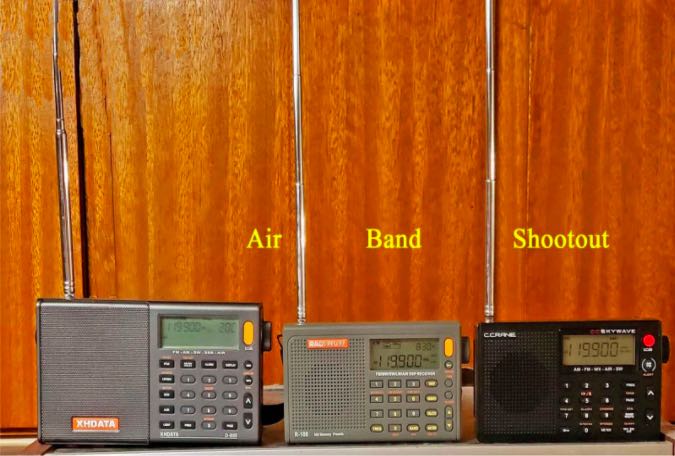 The R-108’s superior FM performance is not repeated on the Shortwave bands, where its capabilities are about average. With the whip antenna copied from the Skywave model it can match the Skywave’s reception of fringe Shortwave stations, although in each DSP setting there is a bass-oriented audio response which differs from the Skywave’s treble-oriented audio. In addition the volume control’s strange twisting/ buzzing quirk (mentioned in the MW-DXing Test Drive) also appears on some fringe Shortwave frequencies, although it is not as noticeable. All 10 of my R-108 test models have a quirk in the direct entry of Shortwave frequencies below 10,000 kHz—if you attempt to directly enter these frequencies after pressing the “FREQ” button nothing will happen unless you press the “FREQ” button a second time after entering in the frequency. Shortwave sensitivity and selectivity are adequate for receiving the strong international broadcasters but this is not a portable that will thrill a dedicated specialist. The model’s plug-in antenna jack allows the user to replace the relatively short (19.3”/ 49cm) whip antenna with either the 3m long wire antenna (supplied) or a custom design, but once again modest expectations are in order.
The R-108’s superior FM performance is not repeated on the Shortwave bands, where its capabilities are about average. With the whip antenna copied from the Skywave model it can match the Skywave’s reception of fringe Shortwave stations, although in each DSP setting there is a bass-oriented audio response which differs from the Skywave’s treble-oriented audio. In addition the volume control’s strange twisting/ buzzing quirk (mentioned in the MW-DXing Test Drive) also appears on some fringe Shortwave frequencies, although it is not as noticeable. All 10 of my R-108 test models have a quirk in the direct entry of Shortwave frequencies below 10,000 kHz—if you attempt to directly enter these frequencies after pressing the “FREQ” button nothing will happen unless you press the “FREQ” button a second time after entering in the frequency. Shortwave sensitivity and selectivity are adequate for receiving the strong international broadcasters but this is not a portable that will thrill a dedicated specialist. The model’s plug-in antenna jack allows the user to replace the relatively short (19.3”/ 49cm) whip antenna with either the 3m long wire antenna (supplied) or a custom design, but once again modest expectations are in order.
The R-108 model had a final surprise to deliver in detailed testing—pretty good AIR band function, with reception of fringe signals just a shade below that of the CC Skywave. Apparently XHDATA/ Radiwow have access to a DSP chip that provides excellent performance on both the FM and AIR bands, with the D-808 leading the pack from 118-137 MHz. In the case of the R-108 its audio amp once again tends to bail out on extremely weak fringe stations (as on MW), but overall sensitivity on this band is decent, and capable of tracking down fringe transmissions. Unlike the D-808 manual the R-108’s user guide explains the Squelch operation in detail, with setup and function identical to the larger model. Squelch level may be set from 1 to 9 by long-pressing and rotating the tuning knob, although with the drastic downturn in air traffic related to the Pandemic the R-108’s AIR band capability may not provide as much enjoyment as in previous years.
Tecsun PL-330
Tecsun’s newest Ultralight-sized model includes SSB capability, and is the latest of these Shootout contestants to be introduced. The first PL-330 models were all intended for the Chinese market, and came out in mid-2020 with a detailed 26-page manual in Chinese (which is still what you will receive from a Chinese vendor, unless you are specifically promised an English manual). Earlier this year the eBay vendor “Anon-co” started offering an “English Version” PL-330, which includes the critically important 27 page English manual—absolutely necessary for most English speakers to understand the functions of the radio.
The PL-330 is an AM-FM-SW-LW receiver with an SSB tuning system that works just as well as those of the Skywave SSB or XHDATA D-808—at a significantly lower cost. It uses a Step control to lower the SSB tuning rate down to 10 kHz steps on the main tuning knob—a system which works on both MW and SW (although the English manual says absolutely nothing about how to do this on either band, leaving the user in the dark about how to fine tune an SSB signal). Frequency coverage is from 520-1710 kHz (MW), 64-108 MHz (FM), 1711-29,999 kHz (SW) and 153-513 kHz (LW). Like the other contestants there are multiple ways to tune in stations such as direct keypad entry (without the need to first press a “Freq.” Button), manual rotation of the tuning knob and an ATS digital search system which will track down stations and store them in memory. Unlike all the other contestants in this Shootout the PL-330 has only 3 DSP filtering choices on MW (2.5, 3.5 and 9 kHz)– a limitation which will certainly reduce the model’s appeal to transoceanic DXers requiring high selectivity in splatter-filled environments. What makes the DSP filter selection really interesting is that the user is required to press a switch and make his choice by rotating the volume control—an arrangement that seems pretty bizarre. Unique among these Shootout contestants is a Synch detector function, which despite three full pages used to explain it in the manual rarely seems to work as Tecsun intended.
Unlike the XHDATA/ Radiwow models the PL-330 makes no attempt at powerful, high fidelity audio— instead using a 1 7/8” (48mm) 250mw speaker with predictably harsh, treble-oriented response. Despite this the audio amplifier will never wimp out on extremely weak MW stations (as typically happens with the Radiwow R-108), delivering as much signal and noise as you care to tolerate. Included in the PL-330 package are the radio, a protective vinyl case, a BL-5C (3.7 volt) lithium battery (which is separated from the radio during shipment, to comply with postal regulations), a set of plug-in earphones, a USB charging cable and either a 27 page English manual (only from the eBay vendor “Anon-co” at this time), or a 26-page Chinese manual (apparently from every other Chinese vendor). Unlike all the other Shootout contestants the PL-330 doesn’t come with either a plug-in or clip-on external wire antenna for FM and SW, although it does have a plug-in jack for such antennas. Currently all of the PL-330 models offered are from either China or Hong Kong, and pricing averages about $79 (plus $5 shipping) to the USA. Interested hobbyists should make every effort to purchase from an honest, reliable seller with a good track record—since like all the China-brand models in this Shootout the owner’s manual has no mention of any company warranty offered on the radio. My three PL-330 test models all seem to have good quality control, but if you receive a defective model you will be totally dependent on the overseas seller, since Tecsun offers no warranty or exchange.
Tecsun PL-330—MW-DXing Test Drive
In comparison to the other Ultralight-sized contestants in this Shootout the PL-330 has one major advantage (SSB capability) and one major disadvantage (limited DSP filtering). Tecsun could have had a breakthrough Ultralight model if they would have offered the full range of DSP choices in addition to SSB capability, but now the overall result is an oddball model with limited versatility. The 2.5 kHz DSP choice is inadequate to limit splatter from strong domestic stations, and also places this model at a disadvantage in receiving extremely weak stations in noisy environments. To balance out this drawback the PL-330’s SSB capability allows the DXer to easily check transoceanic carrier strength to track propagation changes, and transoceanic “big gun” frequencies can be put in memory to assess whether propagation favors a certain part of the world. Lacking a fine-tuning control like the D-808, the SSB tuning system uses switched-in 10 kHz tuning steps on the main tuning control like the Skywave SSB, a routine which works well after some practice. Almost all reviewers have noted that the PL-330’s Synch detector is practically useless, and I would certainly agree with that assessment– in weak signal MW-DXing it was tough to detect a Synch lock on any fringe station.
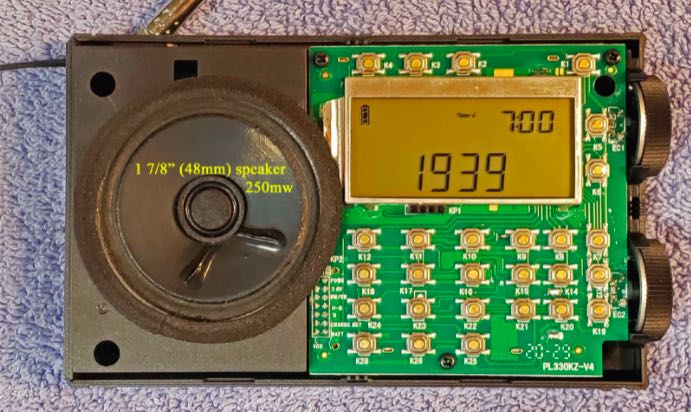 Unlike the XHDATA and Radiwow models the PL-330’s audio fidelity and 1 7/8” (48mm) speaker are pretty mediocre, with a 250mw-rated speaker delivering plenty of audio, but with a strong treble bias. Various weak stations can be received with strong, noisy audio, but almost always with some splatter that could have been avoided with a 1 kHz DSP filter. Changing between the three available DSP filter choices (2.5 kHz, 3.5 kHz and 9 kHz) is also an interesting experience, requiring the user to first press the “AM BW” button, then rotate the volume control to make a filter selection, and then press the “AM BW” button again to restore the main display. Since the PL-330’s loopstick is exactly the same long length (3.85”/ 98mm) as that of the XHDATA D-808 a user might surmise that MW sensitivity should be equivalent with that non-Ultralight model– but in reality the D-808 wins every time. Unlike the D-808 the display light will not dazzle you in dark environments, though, and the stock BL-5C lithium battery seems to provide more generous run time than the Radiwow BL-5C batteries supplied with the R-108 (although nowhere near the 18650 of the D-808 or dual AA supply of the CC Skywave). Overall, Tecsun’s design of this new PL-330 is uninspiring to a serious MW-DXer who requires both top sensitivity and top DSP selectivity. SSB capability is nice, but without strong performance in the first two categories a pocket radio will always get shot down in this Shootout.
Unlike the XHDATA and Radiwow models the PL-330’s audio fidelity and 1 7/8” (48mm) speaker are pretty mediocre, with a 250mw-rated speaker delivering plenty of audio, but with a strong treble bias. Various weak stations can be received with strong, noisy audio, but almost always with some splatter that could have been avoided with a 1 kHz DSP filter. Changing between the three available DSP filter choices (2.5 kHz, 3.5 kHz and 9 kHz) is also an interesting experience, requiring the user to first press the “AM BW” button, then rotate the volume control to make a filter selection, and then press the “AM BW” button again to restore the main display. Since the PL-330’s loopstick is exactly the same long length (3.85”/ 98mm) as that of the XHDATA D-808 a user might surmise that MW sensitivity should be equivalent with that non-Ultralight model– but in reality the D-808 wins every time. Unlike the D-808 the display light will not dazzle you in dark environments, though, and the stock BL-5C lithium battery seems to provide more generous run time than the Radiwow BL-5C batteries supplied with the R-108 (although nowhere near the 18650 of the D-808 or dual AA supply of the CC Skywave). Overall, Tecsun’s design of this new PL-330 is uninspiring to a serious MW-DXer who requires both top sensitivity and top DSP selectivity. SSB capability is nice, but without strong performance in the first two categories a pocket radio will always get shot down in this Shootout.
Tecsun PL-330—FM-DXing Test Drive
The PL-330’s FM sensitivity is about average for a DSP chip-enhanced pocket radio, but in comparison to an innovative FM radio like the Radiwow R-108 it struggles to pull in weak fringe stations– with a whip antenna almost exactly the same length. The R-108 also greatly outclasses the PL-330 in audio signal quality and speaker power, although unlike the R-108 the PL-330’s audio amp will never wimp out on extremely weak fringe stations, and can deliver as much harsh-sounding audio as you care to tolerate.
In a 3-way contest with the R-108 and CC Skywave the PL-330 again confirms its modest FM sensitivity by typically pulling in a single weak fringe station on frequencies where the Skywave can often pull in two weak stations, and where the R-108 can pull in both at a fairly decent level– with audio far superior to the other two models. Although the PL-330 doesn’t come with either a plug-in or clip-on wire antenna, plugging in one of these from another model can boost up the lackluster FM performance somewhat if the antenna is oriented in exactly the right direction—but it can’t increase the PL-330’s ability to compete with other Shootout models using the same antenna. Overall the FM performance of Tecsun’s new model is uninspiring, and dedicated FM-DXing enthusiasts should probably opt for a different model.
Shortwave Performance
In an unusual feature among these contestants the PL-330 combines SSB capability in an Ultralight-sized cabinet, so I was most interested in investigating its Shortwave sensitivity– especially in the reception of weak SSB signals (note: the Skywave SSB model can also perform such a function, but at a price of $169.99, or about $100 more than the PL-330 price). I was also eager to try out the SSB tuning systems of the PL-330, D-808 and Skywave SSB models to compare the “user friendliness” of each model, and make my judgement on the relative ease of tuning in weak SSB signals during an amateur radio contest weekend (March 27-28, 2021).
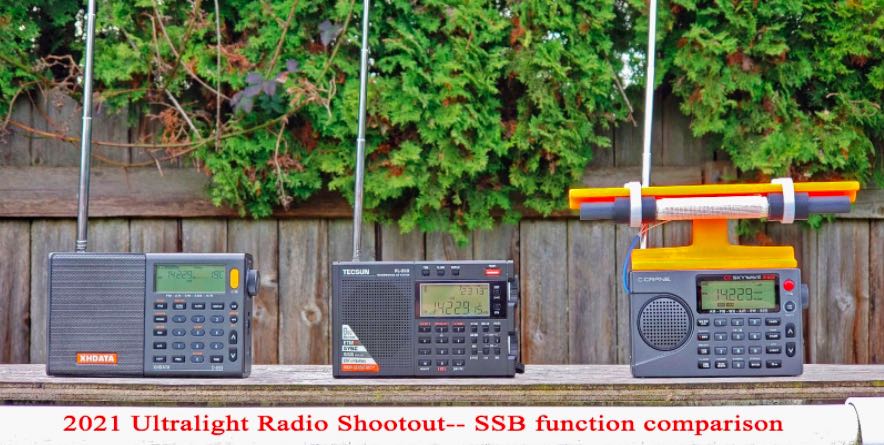 As for Shortwave sensitivity, on its whip antenna the PL-330 was fully competitive with the XHDATA D-808 in receiving the dwindling number of international broadcast stations, and has enough audio amp power to dig out the really weak ones (although with pretty harsh, treble-dominated audio). In comparison with the R-108 and Skywave the PL-330’s Shortwave sensitivity is at least as good, providing a capable asset for chasing weak SSB signals if desired.
As for Shortwave sensitivity, on its whip antenna the PL-330 was fully competitive with the XHDATA D-808 in receiving the dwindling number of international broadcast stations, and has enough audio amp power to dig out the really weak ones (although with pretty harsh, treble-dominated audio). In comparison with the R-108 and Skywave the PL-330’s Shortwave sensitivity is at least as good, providing a capable asset for chasing weak SSB signals if desired.
The SSB tuning system on the PL-330 is based on switching in a slower 10 Hz tuning rate on the main tuning knob, and then using the 10 Hz steps to fine tune an SSB signal for maximum intelligibility. There is a “Step” button used to toggle between a 1 kHz tuning rate and the 10 Hz rate in the SSB mode, so that you can use the 1 kHz steps to search out SSB signals and get them as close as possible to intelligible, and the 10 Hz steps to fine tune them. Unfortunately this “Step” button is recessed down to the same level as the display (an issue also affecting the “ETM” button), making it difficult to press except with the corner of a fingernail. This is a puzzling ergonomic quirk, because simply pressing down on the button with a fingertip will accomplish nothing. Once the DXer masters the dual tuning rate and also masters fingernail pressing of the “Step” control the SSB tuning system works quite well, although you will need to know whether LSB or USB is used on the band you select. In comparison to the Skywave SSB and D-808 the PL-330’s tuning system most resembles that of the Skywave, with a switched-in fine tuning system on the main tuning knob. Unique among these models the PL-330 has selectable buttons for LSB and USB, while the Skywave uses a single button to toggle between the two. This is in contrast to the D-808, which requires you to short press the “Lock” button to toggle between LSB and USB. This odd quirk may be balanced out somewhat by the D-808’s separate thumbwheel for fine tuning of SSB signals. Overall the SSB function and tuning of the PL-330 can be mastered pretty quickly, with ultimate performance equal to that of the two more expensive models. As such, this model should prove to be popular with hobbyists desiring an effective SSB capability in a compact, reasonably-priced portable.
For those with technical skill, replacing the PL-330 stock loopstick with a 7.5 inch (19cm) transplant will boost up MW sensitivity (or LW sensitivity) to a very respectable level on this SSB-equipped model.
C. Crane Skywave (Basic and SSB)
This compact, versatile AM-FM-SW-AIR-Weather Band portable was introduced in 2014 and reviewed extensively in the 2015 Ultralight Radio Shootout– where it gained acclaim for its MW-DXing performance and freedom from digital quirks. Both the basic model and the SSB-enhanced version (introduced in 2017) required substantial R&D investments by C. Crane, resulting in relatively high retail prices for both radios. Unfortunately much of the innovative circuitry in both models was eagerly copied and duplicated by Chinese startup companies located in the same city as C. Crane’s Redsun manufacturing partner—Shenzhen, China. Not only did the Chinese startups benefit from C. Crane’s serious R&D investment but they had the chance to improve upon the Skywave’s weak points—notably the 1.5” (37mm) speaker with its 500mw output and the relatively high prices. But even after six years of providing “inspiration” to the Chinese competition, the Skywave is still unmatched in providing Ultralight-sized MW-DXing capability and warranty-backed quality. The compact radio almost seems custom-designed for serious MW-DXers, who are willing to pay the price for guaranteed reliability.
The Skywave includes coverage of the AM (520-1710 kHz), FM (76-108 MHz), SW (2300-26100 kHz for the basic model, and 1711-29999 kHz for the SSB model), AIR (118-137 MHz), and unique among these Shootout contestants, 7 Weather Band frequencies (with a Weather Alert function, selectable for 4, 8 or 16 hours). Unlike all the other models in this Shootout there is no Longwave band coverage—although to be honest, the Longwave band sensitivity in these other models is very poor.
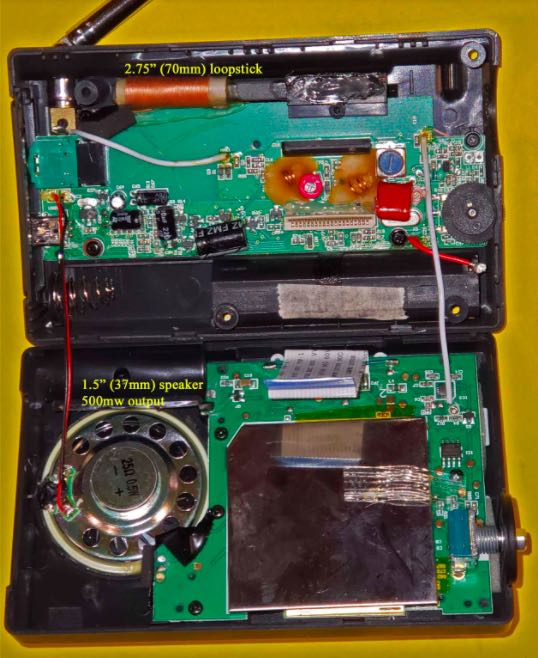 Although both the basic Skywave and the SSB model are significantly more expensive than their Chinese competition, C. Crane makes no attempt to match the multiple digital search functions and display options offered by the PL-380 and related units—and the user will quickly discover that simplicity and basic function is the order of the day. There is only one digital search mode (ATS), no selectable display light (although pressing one of the controls will get you about 12 seconds of temporary lighting), no volume level display, 400 memories (which the owner’s manual does not tell you) and a very basic bar graph display of signal strength. Early basic Skywave models had a rather wimpy audio amplifier, but this has been corrected in firmware revisions. One superior feature of both Skywave models is the extended run time from their two (1.5 volt) AA battery supply—which with quality alkaline batteries will power the models far past any competitive radios in this Shootout. Another superior feature is the one year warranty offered on both models, and C. Crane’s highly respected customer service reputation. The basic Skywave comes with an owner’s manual, carrying case, warranty registration card and CC Bud earphones, and is available for $89.95 (with free shipping to the USA) from Amazon.com. The SSB model comes with all the above items plus a CC Shortwave Reel Antenna, and the current lowest price is $169.99 (with free shipping to the USA) from Amazon.com. The relatively high price is certainly related to the substantial R&D cost necessary to develop the SSB model, which was a considerable breakthrough in 2017 when it was first introduced. Unfortunately, copying of foreign intellectual property is routine and rampant in China, and the Skywave SSB model soon became somewhat of a poster child for this shady practice.
Although both the basic Skywave and the SSB model are significantly more expensive than their Chinese competition, C. Crane makes no attempt to match the multiple digital search functions and display options offered by the PL-380 and related units—and the user will quickly discover that simplicity and basic function is the order of the day. There is only one digital search mode (ATS), no selectable display light (although pressing one of the controls will get you about 12 seconds of temporary lighting), no volume level display, 400 memories (which the owner’s manual does not tell you) and a very basic bar graph display of signal strength. Early basic Skywave models had a rather wimpy audio amplifier, but this has been corrected in firmware revisions. One superior feature of both Skywave models is the extended run time from their two (1.5 volt) AA battery supply—which with quality alkaline batteries will power the models far past any competitive radios in this Shootout. Another superior feature is the one year warranty offered on both models, and C. Crane’s highly respected customer service reputation. The basic Skywave comes with an owner’s manual, carrying case, warranty registration card and CC Bud earphones, and is available for $89.95 (with free shipping to the USA) from Amazon.com. The SSB model comes with all the above items plus a CC Shortwave Reel Antenna, and the current lowest price is $169.99 (with free shipping to the USA) from Amazon.com. The relatively high price is certainly related to the substantial R&D cost necessary to develop the SSB model, which was a considerable breakthrough in 2017 when it was first introduced. Unfortunately, copying of foreign intellectual property is routine and rampant in China, and the Skywave SSB model soon became somewhat of a poster child for this shady practice.
C. Crane Skywave—MW-DXing Test Drive
The Skywave is the only Ultralight-sized model in this Shootout which has a full range of DSP selectivity choices (6, 4, 3, 2 and 1 kHz) as well as typical freedom from all MW digital quirks. (Note: the D-808 also manages this in a larger cabinet, while the PL-330 only has three DSP choices. The R-108 and PL-380 typically have digital quirks on MW, although they probably could be tolerated by most users.) In comparison to the non-Ultralight D-808 the Skywave’s shorter loopstick does result in slightly less sensitivity in tracking down weak fringe stations, but most serious DXers augment the Skywave’s MW sensitivity with either a transplanted external loopstick or an inductively coupled tuned loop.
Since the CC Skywave has been a frequent DXing companion of mine during many ocean cliff and exotic island vacations over the past six years I have had the chance to test it in all types of weather extremes, with a few unplanned “drop tests” and severe travel bumps—and the models have all survived every challenge. In the same theme, Paul Walker has recently subjected the model to extensive subzero (F) temperatures during Alaskan winter DXing, with excellent results. As far as build quality and reliability the Skywave is rock-solid, with only the XHDATA D-808 model equaling it in very rough conditions. For the average DXer considering the performance of a stock Skywave against a stock D-808 I would have to recommend the latter because of its MW sensitivity edge, but the compact Skywave would get the nod when any type of external antenna is brought into play, especially during travel or portable DXing situations when a spare is packed along. The D-808’s speaker audio fidelity and power are more impressive, but once again this advantage is minimal when headphones are brought into play, and after recent firmware revisions the Skywave’s audio amp will provide all of the speaker audio you desire to track down extremely weak fringe stations—as long as you are not looking for high fidelity audio out of the 1.5” (37mm) speaker.
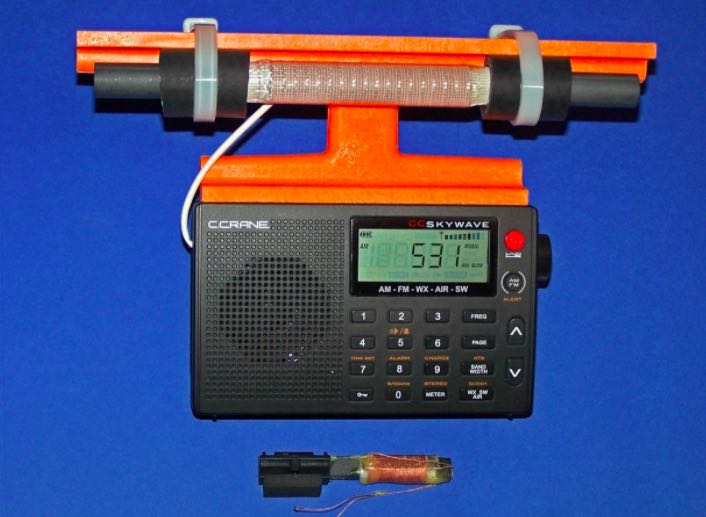 The Skywave’s 1 kHz DSP audio sounds a little different from the equivalent audio of the D-808, although personal preference would probably come into play in choosing one over the other. I made two MP3 recordings of the transoceanic DX station 837-Harbin (in China) under identical setups using the 1 kHz DSP audio settings on both models—recording the exact same segment with identical antennas. The Skywave’s audio MP3 is posted at https://dreamcrafts.box.com/s/ohir8dxsqt1jkgmk3dx9o2krndrccsxt
The Skywave’s 1 kHz DSP audio sounds a little different from the equivalent audio of the D-808, although personal preference would probably come into play in choosing one over the other. I made two MP3 recordings of the transoceanic DX station 837-Harbin (in China) under identical setups using the 1 kHz DSP audio settings on both models—recording the exact same segment with identical antennas. The Skywave’s audio MP3 is posted at https://dreamcrafts.box.com/s/ohir8dxsqt1jkgmk3dx9o2krndrccsxt
while the XHDATA D-808’s audio MP3 is posted at https://dreamcrafts.box.com/s/nri81cfsj8vjt5jg8o9qwjrc62vnd5g4
When I solicited the opinions of my fellow TP-DXers concerning these two MP3’s the majority of the respondents favored the D-808 audio—which ran contrary to my own opinion.
Because of its relatively light weight, the full range of DSP filtering choices, extended battery run time and freedom from MW digital quirks the Skywave is ideal when external antennas are brought into play, although the 7.5” (19cm) loopstick transplant procedure (shown in the photo above) is a pretty severe test of technical skill because of the model’s tightly crammed circuitry. Build quality is excellent and disassembly is fairly routine, but the Skywave’s crammed circuitry fits together like pieces of a puzzle– so if you aren’t aware of C. Crane’s confidential “puzzle routine” (and have above average soldering skill) it’s probably best to avoid “on the job training.” The SSB capability of the more expensive model is very useful for checking the carrier strength of transoceanic stations during propagation changes, and for evaluating the strength and direction of any long range DX openings while on isolated ocean beaches. Overall the Skywave is a thrilling radio for serious MW-DXers– especially those who are looking for the best performance in the most lightweight, compact size.
C. Crane Skywave—FM-DXing Test Drive
The Skywave’s FM-DXing capabilities are about average for a DSP-chip enhanced pocket radio, with sensitivity (on the stock whip antenna) adequate for casual DXing, but falling a little short of the state of the art (currently represented by the Ultralight class-leading R-108). On the weakest FM fringe stations the Skywave can typically pull in marginal, treble-dominated audio while the R-108 usually manages somewhat better signal strength along with far better audio quality. On the other hand the Skywave typically edges out the Tecsun PL-330 in the reception of weak FM stations, and will typically beat out any pocket radio without an advanced DSP chip. When the basic Skywave model was introduced in 2015 its FM sensitivity was already a step below that of the class-leading Tecsun PL-310ET, and XHDATA/ Radiwow have widened the gap with their innovative R-108, which brings a new level of FM-DXing performance to the Ultralight class. Potential purchasers should be aware that the Skywave’s FM band coverage (from 76-108 MHz) is limited in comparison to the other Shootout contestants, which all include coverage from 64-108 MHz—which could be an important factor if you plan any FM-DXing or listening outside of North America. On the other hand the Skywave SSB’s included reel antenna can boost up the radio’s FM capabilities quite a bit if the user orients the wire at the proper direction and height to chase a specific fringe station. In general the Skywave’s FM performance is OK for a casual listener, but is unlikely to satisfy a dedicated FM-DXer.
Shortwave Performance
The basic Skywave’s shortwave sensitivity was fully reviewed in the 2015 Shootout article, where it was judged to be about equal with that of the Eton Traveler III, and a step below that of the class-leading Tecsun PL-310ET. In the highly competitive 2021 pocket radio market the model’s shortwave sensitivity is once again adequate, but not particularly impressive. It can match the shortwave sensitivity of the R-108 but falls slightly short of the other models when signals are very weak. The Skywave’s stock whip antenna (at 49cm) matches that of the R-108 in having the shortest length among these radios—so that could be a factor resulting in both models’ average sensitivity. The longer whip antennas of the other models do seem to provide a slight edge in fringe shortwave reception when conditions are really rough, although the Skywave SSB model includes a high quality Shortwave Reel Antenna as part of the package—which certainly can boost up the model’s shortwave performance dramatically when it is deployed.
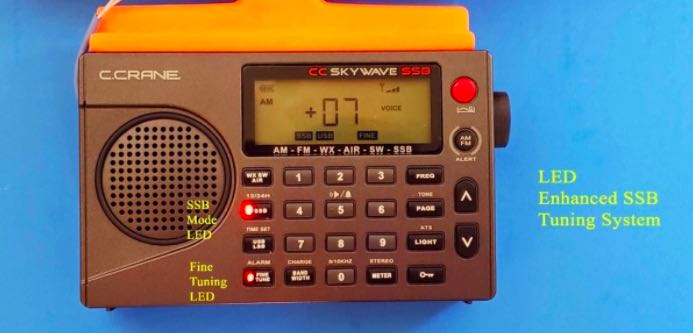 Crane was the first manufacturer to introduce a reliable, highly stable SSB reception capability in an Ultralight-sized cabinet back in 2017—a capability which certainly provided “inspiration” for the XHDATA D-808 and Tecsun PL-330 models. With practice a DXer can become skillful in using the SSB tuning system of any of these models, but the Skywave SSB’s system allows you to switch easily between LSB and USB (unlike the D-808, which requires you to toggle the “Lock” button to do this), and avoids ergonomic quirks such as the sunken “Step” button on the PL-330. Unlike the Chinese competition the Skywave SSB has red LED lights on both the SSB and Fine Tuning buttons, which light up to indicate use of these features when tuning in SSB signals. Features such as these make the Skywave’s SSB tuning system the most user-friendly of the three models, in my opinion. Of course, when the Tecsun PL-330 provides the exact same SSB tuning capability in a model costing about $100 less, many DXers would be willing to forego all of these Skywave SSB advantages—even if they need to use a fingernail to press the PL-330’s sunken “Step” button.
Crane was the first manufacturer to introduce a reliable, highly stable SSB reception capability in an Ultralight-sized cabinet back in 2017—a capability which certainly provided “inspiration” for the XHDATA D-808 and Tecsun PL-330 models. With practice a DXer can become skillful in using the SSB tuning system of any of these models, but the Skywave SSB’s system allows you to switch easily between LSB and USB (unlike the D-808, which requires you to toggle the “Lock” button to do this), and avoids ergonomic quirks such as the sunken “Step” button on the PL-330. Unlike the Chinese competition the Skywave SSB has red LED lights on both the SSB and Fine Tuning buttons, which light up to indicate use of these features when tuning in SSB signals. Features such as these make the Skywave’s SSB tuning system the most user-friendly of the three models, in my opinion. Of course, when the Tecsun PL-330 provides the exact same SSB tuning capability in a model costing about $100 less, many DXers would be willing to forego all of these Skywave SSB advantages—even if they need to use a fingernail to press the PL-330’s sunken “Step” button.
AIR Band Performance
When the basic Skywave model was introduced in 2015 it was the first to feature AIR band coverage in an Ultralight-sized cabinet, and C. Crane devoted extensive coverage of that capability in advertising back then. Since that time the XHDATA D-808 has slightly surpassed the Skywave in AIR band sensitivity, though, resulting in the new top level of performance on these frequencies. As part of the Skywave’s compact package the AIR band capability is still a definite plus for travelers interested in airport communication, and for a purchaser primarily interested in the model’s impressive MW-DXing performance the option to monitor airport communication during worldwide DXpedition travel might be the deciding factor in choosing the lightweight Skywave.
Unlike on the D-808 and R-108 the Skywave’s Squelch function only works on the AIR band, and is activated by pressing in the Tuning knob for two seconds, and then adjusting the Squelch level by rotating the same knob. The manual warns that setting up the Squelch function may decrease the radio’s ability to receive the weaker AIR band transmissions (which is true with any portable).
Weather Band Performance
Unique among these models, the Skywave includes coverage of the 7 NOAA (National Oceanic and Atmospheric Administration) weather band channels in the USA, complete with an ALERT function to notify the user whenever a Weather Alert is issued by the local office. This Weather Band function actually works very well, and in the 2015 Shootout the Skywave’s weather channel reception was judged to be far superior to that of two competing models (the Sangean DT-400W and the C. Crane Pocket).
Other Resources
2015 Ultralight Radio Shootout Review (containing a detailed assessment of the basic Skywave model) Gary DeBock’s 2015 Ultralight Radio Shootout Review | The SWLing Post
Tecsun PL-380
The Tecsun PL-380 was a very popular model when first introduced in 2009, quickly gaining acclaim for the breakthrough sensitivity and DSP-enhanced selectivity offered by its Si4734 DSP chip. Along with the original PL-310 model and related Si4734 DSP chip Ultralights like the PL-606 and PL-360, the PL-380 suddenly provided a quantum leap in pocket radio MW-DXing capabilities, not to mention outstanding FM and Shortwave performance—all for around $50. In the 2021 radio market the PL-380 still provides a lot of value for the money, but there is now a lot of new competition from Radiwow, C. Crane and other manufacturers who can offer performance exceeding that of the PL-380 in certain aspects.
The PL-380 is an AM (520-1710 kHz), FM (64-108 MHz), LW (153-513 kHz) and SW (2300-21950 kHz) receiver with seven tuning modes—Easy Tuning Mode (ETM), jog dial manual tuning, auto scan tuning (VF), pre-setting manual scan tuning, memory pre-setting auto scan tuning and memory pre-setting address direct entry tuning. Although there is no AIR band coverage the model has a powerful audio amplifier, multiple display options and extended run time from its two AA battery supply—especially when alkaline cells are used. The author has purchased about 20 of these models since 2009 and in general the quality control record has been fairly good, although the occasional lemon will show up with a defective tuning knob or other quirk. Since the radio has been popular for over 10 years a North American purchaser can order from Amazon (and several other USA vendors) with free shipping for around $48.80, and receive the radio within a few days. Included in the PL-380 package are the radio, a carrying bag, a SW-FM clip-on antenna (there is no plug in jack for an external antenna), a stereo earphone set and a fairly good 29 page English manual (with a separate version printed for Kaito Electronics version models). Sellers like Amazon offer free returns, which is definitely helpful if you should receive a defective model. Purchases of the PL-380 from Kaito Electronics (in the USA) even come with a one year warranty and registration card—which is definitely an advantage. Servicing or replacing a defective radio in your home country is far better than shipping it back to China– especially with the current COVID delays.
Tecsun PL-380—MW-DXing Test Drive
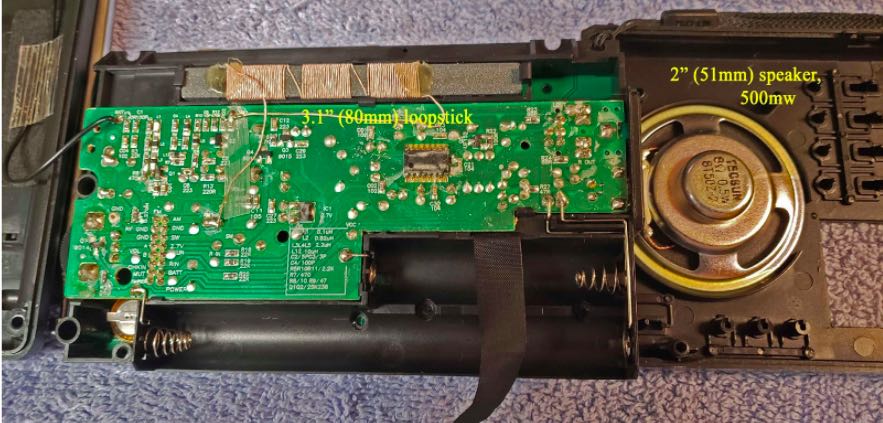 With its eleven year record of DXing performance both the strong points and the weak areas of the PL-380 have become quite well known. Back in 2009 DXers thrilled at the combination of a relatively low price, versatile DSP filtering options and decent sensitivity, although they weren’t so thrilled with internally-generated heterodynes, “soft mute” and muffled-sounding 1 kHz DSP audio. When DXers expressed their desire that Tecsun would correct these issues the company went in the opposite direction in 2012 by quietly removing the shielding around the Si4734 DSP chip in an attempt to increase profits– resulting in a digital whine when the display is grasped in the palm of a hand, and greatly increased noise on the Longwave frequencies. Despite these issues the PL-380 was probably the most popular Ultralight radio for transoceanic DXing during the first 5 years of its production, and the subject of multiple modifications (such as the author’s 7.5 inch loopstick transplant article, posted at https://dreamcrafts.box.com/s/xu7drqxg7epmljm4yu4579hcrin9em6p
With its eleven year record of DXing performance both the strong points and the weak areas of the PL-380 have become quite well known. Back in 2009 DXers thrilled at the combination of a relatively low price, versatile DSP filtering options and decent sensitivity, although they weren’t so thrilled with internally-generated heterodynes, “soft mute” and muffled-sounding 1 kHz DSP audio. When DXers expressed their desire that Tecsun would correct these issues the company went in the opposite direction in 2012 by quietly removing the shielding around the Si4734 DSP chip in an attempt to increase profits– resulting in a digital whine when the display is grasped in the palm of a hand, and greatly increased noise on the Longwave frequencies. Despite these issues the PL-380 was probably the most popular Ultralight radio for transoceanic DXing during the first 5 years of its production, and the subject of multiple modifications (such as the author’s 7.5 inch loopstick transplant article, posted at https://dreamcrafts.box.com/s/xu7drqxg7epmljm4yu4579hcrin9em6p
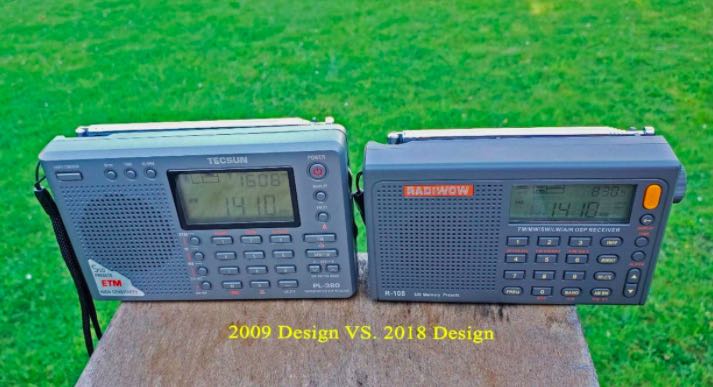 So how does the current Tecsun PL-380 stock model stack up against the 2021 competition? Well, for MW-DXing at a bargain price it is still a good value, with a price and features similar to the Radiwow R-108—which is likely to become its top competitor. Both models have a full range of DSP filtering options, multiple search modes and even common digital quirks on MW. The PL-380 lacks the R-108’s innovative speaker and high fidelity audio, but it has a more powerful audio amp that won’t wimp out on extremely weak MW-DX stations (like the R-108). The PL-380’s three AA battery supply will always outlast the BL-5C “cell phone battery” of the R-108 when alkaline cells are used, and unlike on most of the R-108 models the volume control sounds clear and trouble-free when it is advanced on the high MW band. But as far as MW-DXing quirks, both models have their rough edges. The PL-380 still has the internally generated heterodynes on frequencies like 1310 and 1410 kHz, which don’t show up on the R-108. When the performance on other bands is considered the R-108 offers wider Shortwave coverage (albeit with modest sensitivity) and a very competitive AIR band for about the same price, as well as outstanding FM coverage– with weak signal sensitivity clearly exceeding that of the PL-380. But a serious MW-DXer would certainly choose the PL-380 every time, simply because of its powerful audio amp f tracking down extremely weak stations. When you are really “digging them out” very close to the noise level the Pl-380 is capable of blasting you out with all the weak signal audio you desire– while the R-108’s audio amp tends to bail out well before any ID clues can be deciphered. This is a very stark difference in MW-DXing capability, and should be fully considered before purchasing the latter model. Overall, if a DXer only has $50 to spend and desires a fairly competitive Ultralight radio with the best MW-DXing features for his money, the PL-380 would be an excellent choice.
So how does the current Tecsun PL-380 stock model stack up against the 2021 competition? Well, for MW-DXing at a bargain price it is still a good value, with a price and features similar to the Radiwow R-108—which is likely to become its top competitor. Both models have a full range of DSP filtering options, multiple search modes and even common digital quirks on MW. The PL-380 lacks the R-108’s innovative speaker and high fidelity audio, but it has a more powerful audio amp that won’t wimp out on extremely weak MW-DX stations (like the R-108). The PL-380’s three AA battery supply will always outlast the BL-5C “cell phone battery” of the R-108 when alkaline cells are used, and unlike on most of the R-108 models the volume control sounds clear and trouble-free when it is advanced on the high MW band. But as far as MW-DXing quirks, both models have their rough edges. The PL-380 still has the internally generated heterodynes on frequencies like 1310 and 1410 kHz, which don’t show up on the R-108. When the performance on other bands is considered the R-108 offers wider Shortwave coverage (albeit with modest sensitivity) and a very competitive AIR band for about the same price, as well as outstanding FM coverage– with weak signal sensitivity clearly exceeding that of the PL-380. But a serious MW-DXer would certainly choose the PL-380 every time, simply because of its powerful audio amp f tracking down extremely weak stations. When you are really “digging them out” very close to the noise level the Pl-380 is capable of blasting you out with all the weak signal audio you desire– while the R-108’s audio amp tends to bail out well before any ID clues can be deciphered. This is a very stark difference in MW-DXing capability, and should be fully considered before purchasing the latter model. Overall, if a DXer only has $50 to spend and desires a fairly competitive Ultralight radio with the best MW-DXing features for his money, the PL-380 would be an excellent choice.
Tecsun PL-380—FM-DXing Test Drive
The PL-380 and its Si4734 DSP-chip siblings set a new pocket radio standard with their breakthrough FM performance about 12 years ago, and one of these siblings (the PL-310ET) was the FM sensitivity winner in the 2015 Ultralight Shootout– but how does the PL-380 stack up against the current competition? As reported previously, the Radiwow R-108 is an outstanding performer on the FM frequencies, so it was with great interest that I matched up these two models in a weak signal FM-DXing comparison.
Although the PL-380’s stock whip is 2.4” (6cm) longer than that of the R-108 this FM matchup is really no contest, with the Radiwow model not only pulling in more weak fringe stations, but with better signal strength—and with great audio fidelity as a bonus. The PL-380 can pick up the very weak FM fringe stations with some marginal, spotty audio, while the R-108 makes them sound pretty solid, and often throwing in another unknown fringe station on the same frequency for good measure. The Radiwow R-108 is a phenomenal performer on the FM frequencies, with sensitivity and audio quality in a different league than any other Ultralight—and credit should be given to XHDATA/ Radiwow for their innovation in accomplishing this breakthrough. However the PL-380 is still competitive among the other Ultralights, with weak fringe station reception fairly good for the genre. It can hold its own with the CC Skywave, and slightly edge out the PL-330 on the toughest signals. It has plenty of audio power to chase weak stations, and the included SW-FM clip-on antenna can make a serious difference in fringe station reception if oriented properly. For a dedicated FM-DXer looking for a new level of performance from 64-108 MHz, however, the R-108 deserves your serious attention.
Shortwave Performance
The Tecsun PL-380 (and its Si4734 DSP chip Ultralight siblings) have provided decent shortwave performance for over ten years, and one of those models (once again the PL-310ET) was judged the Shortwave sensitivity winner in the 2015 Ultralight Radio Shootout. But although Shortwave broadcasting has cooled off during the past few years the pocket radio performance competition has only heated up on these frequencies, with Tecsun itself introducing the SSB-capable PL-330, and XHDATA introducing the SSB-capable D-808. Both of these models have a slight Shortwave sensitivity advantage over the PL-380, even though the PL-330’s whip antenna is over 2 inches (5.5cm) shorter. The PL-380 has the additional handicap of limited Shortwave coverage, with its lower limit of 2300 kHz and upper limit of 21950 kHz. The PL-380’s Shortwave performance is still competitive with the non-SSB models in this Shootout, however. It will hold its own against the R-108 and basic Skywave, with more audio amp power than the R-108 to chase really weak fringe stations.
Just like Radiwow’s development of the R-108 has made the PL-380 a runner up in FM performance the Tecsun company deserves credit for developing the PL-330, which makes the PL-380 a runner up in Shortwave performance as well. A dedicated Shortwave enthusiast looking for the best Ultralight reception should definitely opt for the breakthrough SSB-enhanced model, which is the new state of the art in pocket radio Shortwave performance.
SECTION TWO: THE SHOOTOUT
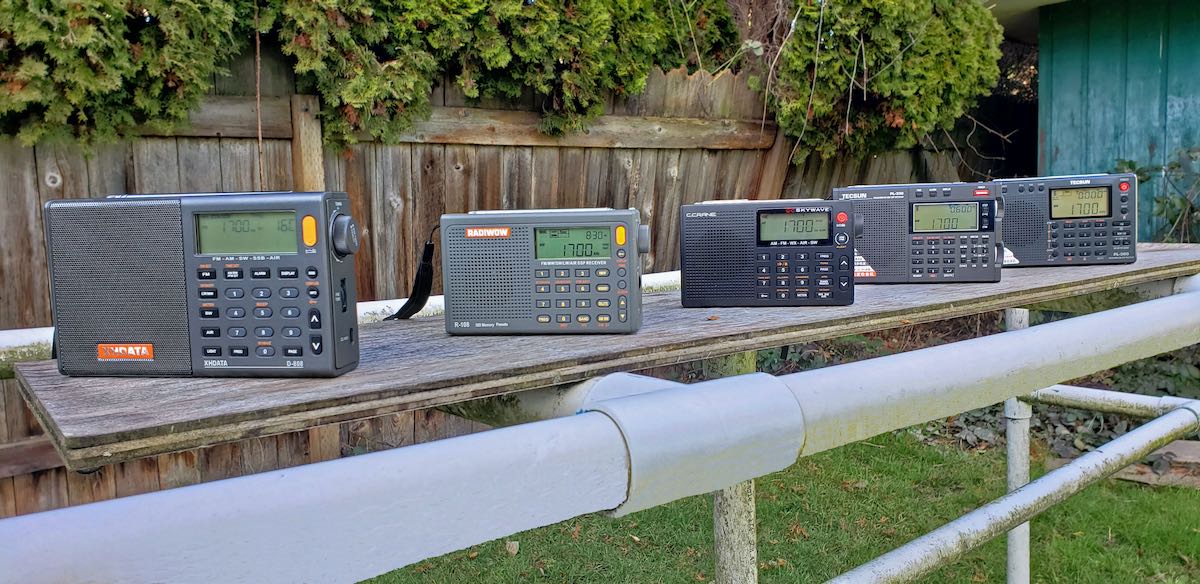 As in the 2015 Ultralight Shootout review, multiple test signal MP3’s were recorded to give each reader a chance to listen to accurate evidence of the relative performance of each model in important categories. These categories were MW sensitivity, MW selectivity, FM sensitivity, Shortwave sensitivity and AIR band sensitivity.
As in the 2015 Ultralight Shootout review, multiple test signal MP3’s were recorded to give each reader a chance to listen to accurate evidence of the relative performance of each model in important categories. These categories were MW sensitivity, MW selectivity, FM sensitivity, Shortwave sensitivity and AIR band sensitivity.
MW Sensitivity Shootout
For the MW Sensitivity test MP3’s weak daytime DX fringe stations were chosen and recorded during hours close to local noon, emphasizing stable ground wave propagation. The daytime DX stations were chosen because of the challenging nature of their signals, which cannot be received on pocket radios without above average sensitivity. Each radio had an equal chance to demonstrate its sensitivity, with all the test signals being recorded within a 5 minute period (during which a stable test signal was ensured), and all loopsticks were oriented in the same direction.
Finally, the radios were switched around to ensure that no position was inferior or superior to any other position. The Tecsun PL-330 was placed in its narrowest (2.5 kHz) DSP filter setting and all other models were placed in their 1 kHz DSP settings (all of which were found to provide the best sensitivity and selectivity for the three models). The Skywave was set in its default “Music” tone selection.
In all the Medium Wave test signal reception MP3’s, the XHDATA D-808 is recorded for the first 15 seconds, followed by the Radiwow R-108 for approximately 15 seconds, followed by the C. Crane Skywave basic model for approximately 15 seconds, followed by the Tecsun PL-330 for approximately 15 seconds, followed by the Tecsun PL-380 for 15 seconds.
550-KARI (Blaine, WA, 5 kW at 135 miles/ 217 km) https://dreamcrafts.box.com/s/o6q4fmtxpuwi3qxoswtdfbfkfil27up7
750-KXTG (Tigard, OR, 50 kW at 112 miles/ 181 km) https://dreamcrafts.box.com/s/pjiftj1j1aytilarehumbugxlugf4oix
1070-CFAX (Victoria, B.C., Canada, 10 kW at 99 miles/ 159 km) https://dreamcrafts.box.com/s/o45ae6ypv6vbjo363sq52rla9wxbwpmp
1470-KELA (Centralia, WA, 5 kW at 45 miles/ 72 km) https://dreamcrafts.box.com/s/s4ojkyu8vsb4kmijh17wsa7q2g6zwpu5
1700-City of Auburn TIS (Auburn, WA, 15 watts at 9 miles/ 15 km) https://dreamcrafts.box.com/s/af68cb9wgwlx6rxlnm2svc5j33pee188
Comments
As expected, the non-Ultralight XHDATA D-808 has a significant sensitivity edge over all the Ultralight-sized models, but the CC Skywave edges out the Radiwow R-108 and the Tecsun PL-380 on extremely weak signals like the 1700-TIS station– primarily because of its clearer, less muffled audio in the 1 kHz DSP setting. The Tecsun PL-330 suffers from its lack of such a narrow DSP filter, with almost no reception of the 1700 kHz signal despite its longer loopstick.
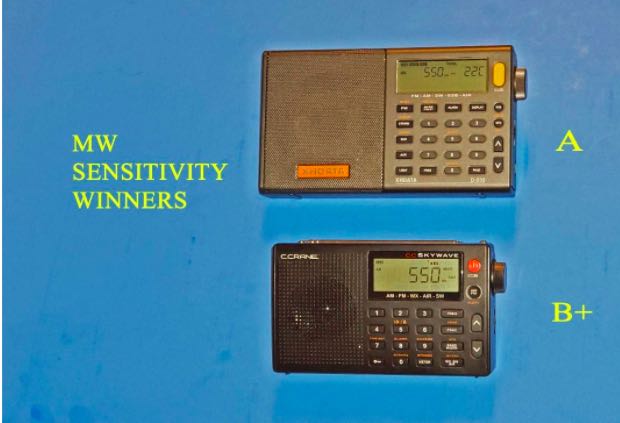 Both the R-108 and the PL-380 have adequate sensitivity on weak signals, but their muffled 1 kHz DSP audio degrades clarity when digging out identity clues. The R-108 has the additional issue of a wimpy audio amp, which bails out when extremely weak signals are being chased.
Both the R-108 and the PL-380 have adequate sensitivity on weak signals, but their muffled 1 kHz DSP audio degrades clarity when digging out identity clues. The R-108 has the additional issue of a wimpy audio amp, which bails out when extremely weak signals are being chased.
MW Sensitivity Grades
XHDATA D-808 A
Crane Skywave B+
Tecsun PL-380 B
Radiwow R-108 B
Tecsun PL-330 B-
MW Selectivity Shootout
During this competition the five competing models were given the very challenging task of receiving weak daytime DX stations very close in frequency to strong local stations. Because some of these stations were quite weak around local noon the test was run a few hours later in the afternoon, but stable daytime DX test signals were still ensured prior to each runoff. In order to maximize reception of the weak fringe stations, the loopsticks of all the competing models were oriented to null the local pest station as much as possible. All models were set to provide 1 kHz DSP selectivity (the narrowest filter) with the exception of the Tecsun PL-330 (which has 2.5 kHz as its narrowest).
Once again, in each MP3 the first 15 seconds are recorded on the XHDATA D-808, followed by approximately 15 seconds on the Radiwow R-108, then approximately 15 seconds on the C. Crane Skywave basic model, followed by approximately 15 seconds on the Tecsun PL-330, followed by 15 seconds on the Tecsun PL-380.
560-KPQ (Wenatchee, WA, 5 kW at 94 miles/151 km) with splatter from 570-KVI (Vashon Island, WA, 5 kw at 5 miles/8 km) https://dreamcrafts.box.com/s/v5loyjliqax6k7k6935kk9iee3jcqfot
810-KTBI (Ephrata, WA, 50 kW at 128 miles/206 km) with splatter from 820-KGNW (Burien, WA, 50 kW at 20 miles/31 km) https://dreamcrafts.box.com/s/qr3pu07vnvot830dy8qpsmhnmrj1lizv
860-KPAM (Troutdale, OR, 50 kW at 114 miles/184 km) with splatter from 850-KHHO (Tacoma, WA, 10 kW at 5 miles/8 km) https://dreamcrafts.box.com/s/snip6wf72hen96v739za5mbnwes12397
1010-KOOR (Milwaukee, OR, 4.5 kW at 116 miles/187 km) with splatter from 1000-KOMO (Seattle, WA, 50 kW at 42 miles/68 km) https://dreamcrafts.box.com/s/l2j1hd05bjcq8hbuwqwshqo8ppizz7v2
1520-KQRR (Oregon City, OR, 50 kW at 129 miles/208km) with splatter from 1510-KSUH spur (Puyallup, WA, 1 kW at 2 miles/3 km) https://dreamcrafts.box.com/s/fk3oizuerv8gh88os2uiax9m79hiig7f
Comments
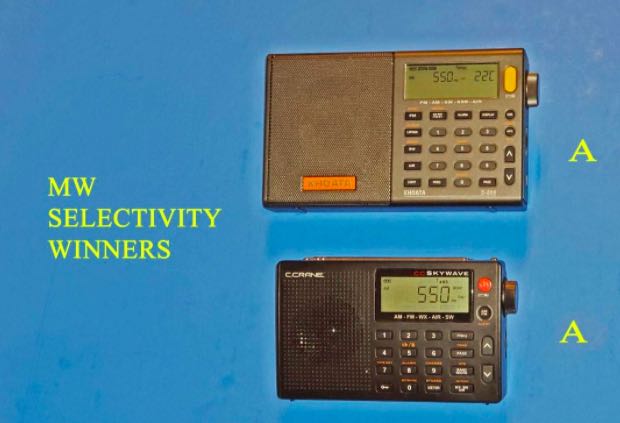 On the toughest fringe signals the XHDATA D-808 and C. Crane Skywave both excel at rejecting splatter while providing usable fringe station audio. The Tecsun PL-380 is a step below them in this category, allowing slightly more splatter to creep in. The Radiwow R-108’s 1 kHz DSP filtering lets in even more splatter, while the Tecsun PL-330 is hopelessly outclassed in this competition because of its lack of 1 kHz DSP filtering– a major drawback for DXers with many local MW pest stations.
On the toughest fringe signals the XHDATA D-808 and C. Crane Skywave both excel at rejecting splatter while providing usable fringe station audio. The Tecsun PL-380 is a step below them in this category, allowing slightly more splatter to creep in. The Radiwow R-108’s 1 kHz DSP filtering lets in even more splatter, while the Tecsun PL-330 is hopelessly outclassed in this competition because of its lack of 1 kHz DSP filtering– a major drawback for DXers with many local MW pest stations.
MW Selectivity Grades
XHDATA D-808 A
Crane Skywave A
Tecsun PL-380 B
Radiwow R-108 B-
Tecsun PL-330 C
FM Sensitivity Shootout
For this competition weak FM fringe stations were chosen to provide a challenging test for each model’s FM sensitivity. The tests were conducted in the open back yard, with each model’s whip antenna carefully oriented to provide the best possible reception of each FM fringe station. Although the tests were not conducted at local noon, stable FM conditions were ensured to provide accurate test results for relative FM sensitivity.
As in the Medium Wave test MP3’s, the first 15 seconds of each MP3 was recorded on the XHDATA D-808, followed by approximately 15 seconds on the Radiwow R-108, then approximately 15 seconds on the C. Crane Skywave basic model, followed by approximately 15 seconds on the Tecsun PL-330, then finally 15 seconds on the Tecsun PL-380.
92.9-KISM (Bellingham, WA, 50 kW at 108 miles/174 km) https://dreamcrafts.box.com/s/nrq6uhs20syn60sv7ic0gl7agiuj5wzu
94.5 KRXY (Olympia, WA, 830w at 21 miles/34 km) https://dreamcrafts.box.com/s/dkyx59i97h57urzqfv7h53cbdonl8geh
100.3 KUCP (Kent, WA, 41w at 17 miles/27 km) https://dreamcrafts.box.com/s/47pbn6meulfne4lgtd0iavnha9rj9isx
102.1 KPQ (Wenatchee, WA, 35 kW at 94 miles/151 km) https://dreamcrafts.box.com/s/u71e4hk3f3ne46jfk2dse2s56fo6oxpi
106.5 KWPZ (Lynden, WA, 68 kW at 122 miles/196 km) https://dreamcrafts.box.com/s/y3la0n3vx4nxrobny1egle9tg6kz0xv3
Comments
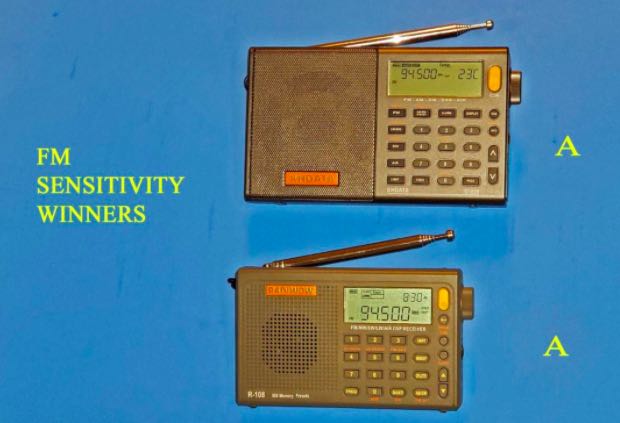 The XHDATA D-808 and the Radiwow R-108 have a slight FM sensitivity edge on the other models, which tend to have pretty similar performance on all of these fringe stations. The R-108’s performance in this aspect is especially noteworthy because of its short whip antenna—tied with that of the Skywave as the shortest among these models. The R-108’s excellent FM performance is enhanced by the superb audio quality offered by its innovative, powerful speaker. Although these fringe stations are pretty much alone on their frequencies, both the D-808 and R-108 are capable of tracking down multiple weak FM stations on frequencies where the other models receive a single station. The C. Crane Skywave and PL-380 have pretty much identical performance, while the Tecsun PL-330 is a shade below these two in overall FM sensitivity.
The XHDATA D-808 and the Radiwow R-108 have a slight FM sensitivity edge on the other models, which tend to have pretty similar performance on all of these fringe stations. The R-108’s performance in this aspect is especially noteworthy because of its short whip antenna—tied with that of the Skywave as the shortest among these models. The R-108’s excellent FM performance is enhanced by the superb audio quality offered by its innovative, powerful speaker. Although these fringe stations are pretty much alone on their frequencies, both the D-808 and R-108 are capable of tracking down multiple weak FM stations on frequencies where the other models receive a single station. The C. Crane Skywave and PL-380 have pretty much identical performance, while the Tecsun PL-330 is a shade below these two in overall FM sensitivity.
FM Sensitivity Grades
XHDATA D-808 A
Radiwow R-108 A
Tecsun PL-380 B
Crane Skywave B
Tecsun PL-330 B-
Shortwave Sensitivity Shootout
For this test the models were tested in the reception of relatively weak Shortwave broadcast stations, chosen over a diverse range of the Shortwave spectrum. Fully extended stock whip antennas were used, and placed in the optimal position for the best possible reception. All models were placed in the 2 kHz DSP filter selection except for the Tecsun PL-330 (which has 2.5 kHz as its narrowest DSP filter). The Skywave’s tone was set in the default “Music” selection.
For these MP3’s the first 15 seconds were recorded on the XHDATA D-808, followed by approximately 15 seconds on the Radiwow R-108, then approximately 15 seconds on the C. Crane Skywave basic model, followed by 15 seconds on the Tecsun PL-330, and finally 15 seconds on the Tecsun PL-380.
5800-WRMI (Okeechobee, FL, USA) https://dreamcrafts.box.com/s/yoivzgmstwj4m7xiywhxefsqnpefs5kb
6165-Radio Havana Cuba (English) https://dreamcrafts.box.com/s/sghn9qmj9znt5sl4njfiy1tkbsswye4q
7335-Radio Marti (Marathon, FL, USA) https://dreamcrafts.box.com/s/kx4v8j48wketypgvcf9y9k7nhqsjirmh
9535-Radio Havana Cuba (Spanish) https://dreamcrafts.box.com/s/ychjqvojs04kt0l5l7j4v3o2vcddbrq9
9330-WBCQ (Monticello, ME, USA) https://dreamcrafts.box.com/s/fi2l14qwlwq5hh894m8jy419mu7fzn0l
Comments
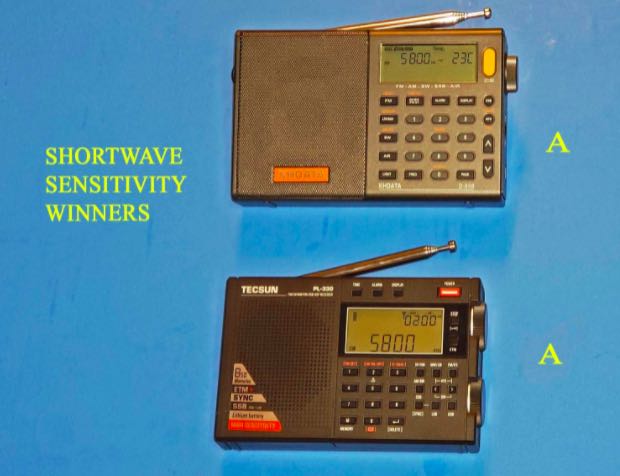 Once again the XHDATA D-808 is unsurpassed in weak signal reception, although the SSB-equipped Tecsun PL-330 manages to equal it in overall Shortwave sensitivity despite having a much shorter whip antenna (6.1 inches/15.5cm shorter). The other three models are fairly close in capability, but in my opinion the Radiwow R-108 is a shade less sensitive than the C. Crane Skywave and Tecsun PL-380 models. The whip antennas of the Skywave and R-108 are the shortest of all these models, so that may be a contributing factor in their Shortwave sensitivity. C. Crane is presumably aware of this, and includes the high quality Shortwave Reel Antenna with every Skywave SSB model (but not with the basic model).
Once again the XHDATA D-808 is unsurpassed in weak signal reception, although the SSB-equipped Tecsun PL-330 manages to equal it in overall Shortwave sensitivity despite having a much shorter whip antenna (6.1 inches/15.5cm shorter). The other three models are fairly close in capability, but in my opinion the Radiwow R-108 is a shade less sensitive than the C. Crane Skywave and Tecsun PL-380 models. The whip antennas of the Skywave and R-108 are the shortest of all these models, so that may be a contributing factor in their Shortwave sensitivity. C. Crane is presumably aware of this, and includes the high quality Shortwave Reel Antenna with every Skywave SSB model (but not with the basic model).
Shortwave Sensitivity Grades
XHDATA D-808 A
Tecsun PL-330 A
Crane Skywave B
Tecsun PL-380 B
Radiwow R-108 B-
AIR Band Sensitivity Shootout
In the 2015 Ultralight Radio Shootout the C. Crane Skywave was unique with AIR band capability in an Ultralight radio, but since then the Radiwow R-108 and the non-Ultralight XHDATA D-808 have both been introduced with that capability. To check which model has “air superiority,” recordings were made of the local airport (Seattle-Tacoma International) tower traffic on 119.9 MHz. All whip antennas were fully extended, and in the noise-free back yard each model recorded the exact same air traffic segment over a one minute period.
XHDATA D-808 https://dreamcrafts.box.com/s/uek67omfkhcigmyx5sjncjyx9bubvd7d
C.Crane Skywave https://dreamcrafts.box.com/s/kg7oiaj4xwqmnpwiqquinps1d5g5ct7v
Radiowow R-108 https://dreamcrafts.box.com/s/oyrvzqj5o3begsclbtntstxqbqkqiblo
Comments
All three models can receive the tower transmissions at 4 seconds (“Over to departure, Horizon 2083 good day”) and at 37 seconds (“Alaska 736 good day”), but that is all that the Radiwow R-108 can receive. The C. Crane Skywave can receive some of the weak aircraft transmission at 22 seconds, but not very much of it. The XHDATA D-808 can also receive the weak aircraft transmission at 2 seconds, in addition to somewhat stronger reception of the weak aircraft transmission at 22 seconds. As such, the D-808 is the winner of this competition, although the Skywave is still fairly competitive. For a bargain model the R-108 will at least provide economy class access to the airport.
Air Band Sensitivity Grades
XHDATA D-808 A
Crane Skywave A-
Radiwow R-108 B
Note: The C. Crane Skywave is unique among these models in receiving the NOAA Weather Band Channels 1-7 in the USA, and has demonstrated superior sensitivity on these frequencies in competition with other Ultralight radios in the 2015 Ultralight Shootout (posted at Gary DeBock’s 2015 Ultralight Radio Shootout Review | The SWLing Post
North American DXers interested in receiving weather information and emergency notifications are encouraged to consider this unique capability in their purchasing decisions.
SECTION THREE: FINAL VERDICTS
XHDATA D-808
As mentioned previously the D-808’s 27.2 cubic inch size places it well outside of the “official” Ultralight Radio category, so it is included in this review for informational purposes only. The longer loopstick, longer whip antenna, larger speaker and powerful audio give it some unfair advantages over the smaller pocket radios, although in the 2021 portable radio market most purchasers are looking for value and performance– and the D-808 certainly delivers on both points. The Chinese engineers (or reverse engineers) have improved upon the Skywave SSB “inspiration” to design a versatile DXing portable with stellar capabilities, offered at a price which is tough to beat. It does have the dazzling display light and the impractical warranty policy, but for DXers looking for high sensitivity, powerful audio, SSB capability and rugged construction this portable will fit the bill. With the asking price all over the map a DXer needs to shop around, though, and make every effort to purchase from a reliable seller that will guarantee the radio’s quality—and not ask you to ship it back to China before taking any customer service action. The vast majority of D-808 purchasers have been very satisfied with their radio, but that will be of little comfort if you are stuck with a defective model.
RADIWOW R-108
 For FM and AIR band DXers this model is a real bargain at the $50 price, although MW and SW DXers are not likely to be impressed. The superior speaker, audio fidelity and digital search modes add to its appeal while the MW digital quirks, somewhat wimpy audio amp and dodgy warranty tend to balance out the equation. FM band DXers who were thrilled by the introduction of the Si4734 DSP chip in the Tecsun PL-310 and PL-380 models a decade ago are in for a pleasant surprise with this model, which combines excellent sensitivity with superior audio quality for an unmatched “fun factor” from 88-108 MHz. In a similar manner AIR band DXers can track down airport communication traffic with fairly good sensitivity, with the option of plugging in an even more effective external antenna on either band. Interested DXers are strongly advised to obtain a premium BL-5C battery to replace the stock model, and purchase the radio from a reputable seller that will back up the quality of their R-108 models– preferably in your own home country. Speaking from experience, the last thing you need is a defective model that must be shipped back to China (at your expense) before the seller will contemplate any exchange. XHDATA/ Radiwow currently has no repair or service facilities in either North America or Europe, so consider yourself forewarned.
For FM and AIR band DXers this model is a real bargain at the $50 price, although MW and SW DXers are not likely to be impressed. The superior speaker, audio fidelity and digital search modes add to its appeal while the MW digital quirks, somewhat wimpy audio amp and dodgy warranty tend to balance out the equation. FM band DXers who were thrilled by the introduction of the Si4734 DSP chip in the Tecsun PL-310 and PL-380 models a decade ago are in for a pleasant surprise with this model, which combines excellent sensitivity with superior audio quality for an unmatched “fun factor” from 88-108 MHz. In a similar manner AIR band DXers can track down airport communication traffic with fairly good sensitivity, with the option of plugging in an even more effective external antenna on either band. Interested DXers are strongly advised to obtain a premium BL-5C battery to replace the stock model, and purchase the radio from a reputable seller that will back up the quality of their R-108 models– preferably in your own home country. Speaking from experience, the last thing you need is a defective model that must be shipped back to China (at your expense) before the seller will contemplate any exchange. XHDATA/ Radiwow currently has no repair or service facilities in either North America or Europe, so consider yourself forewarned.
C.CRANE SKYWAVE
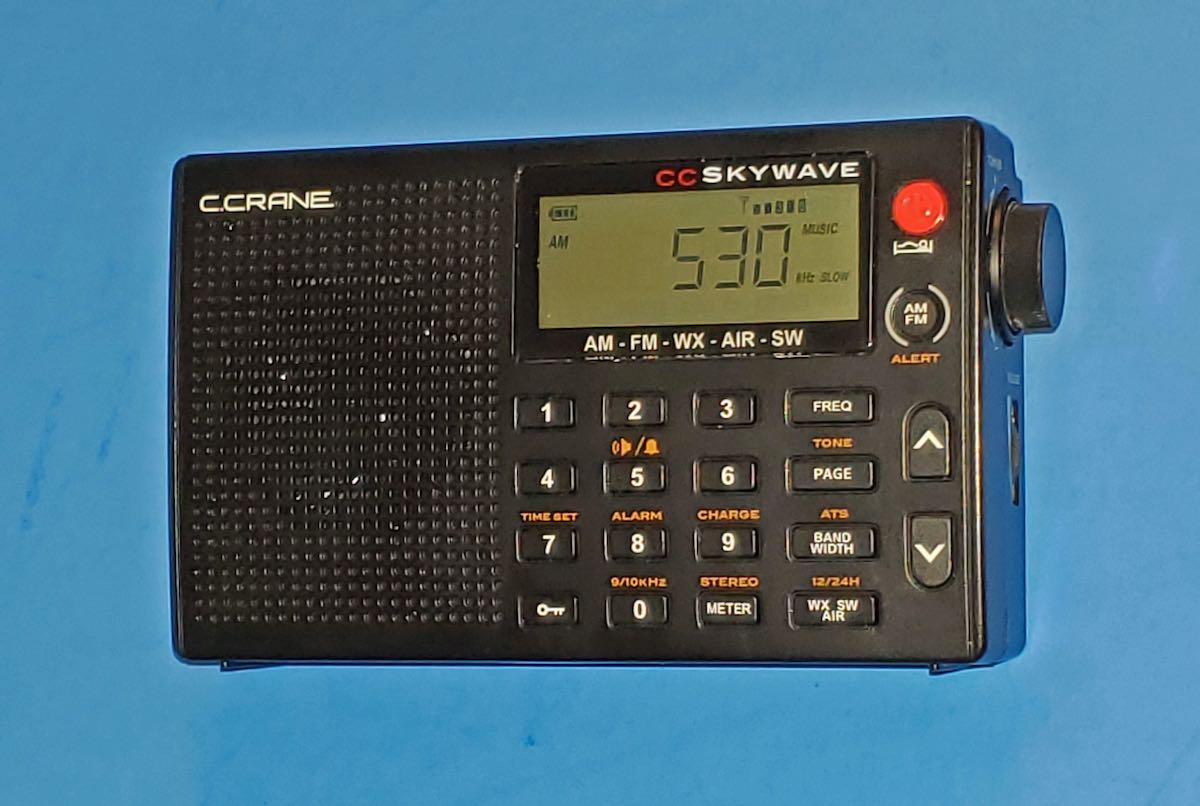 For compact MW-DXing performance with guaranteed quality and reliability the Skywave retains its top position in the 2021 pocket radio market, although the innovative models from XHDATA and Radiwow have surpassed it on FM, and the D-808 has slightly surpassed it on the AIR band. The D-808 manages a slight edge in stock shortwave sensitivity as well. If DXing on any of these bands is your top priority this model is probably not the best choice, although the Skywave SSB’s shortwave performance is greatly improved with the included Shortwave Reel Antenna.
For compact MW-DXing performance with guaranteed quality and reliability the Skywave retains its top position in the 2021 pocket radio market, although the innovative models from XHDATA and Radiwow have surpassed it on FM, and the D-808 has slightly surpassed it on the AIR band. The D-808 manages a slight edge in stock shortwave sensitivity as well. If DXing on any of these bands is your top priority this model is probably not the best choice, although the Skywave SSB’s shortwave performance is greatly improved with the included Shortwave Reel Antenna.
C. Crane’s technical breakthrough in developing this innovative Ultralight SSB model essentially went to naught in China, where the model’s technical secrets were eagerly copied by local competitors– without any R&D investment of their own. This makes it difficult for C. Crane to compete with the competitors on pricing, which in turns detracts from a high quality model with impressive capabilities. The Skywave’s SSB tuning system is very user-friendly, the build quality is outstanding and no other model offers its combination of MW-DXing competence in such a compact package. It’s certainly true that both the basic Skywave and the SSB model are facing severe competition, but for those who are willing to pay the price for guaranteed quality and rugged survivability on the MW band and Weather Channels the Skywave will not disappoint. Evaluate your DXing priorities with the honest comparisons contained in this article, and if a combination of outstanding MW-DXing features and compact portability is your primary desire, the Skywave could well become your dream model.
TECSUN PL-330
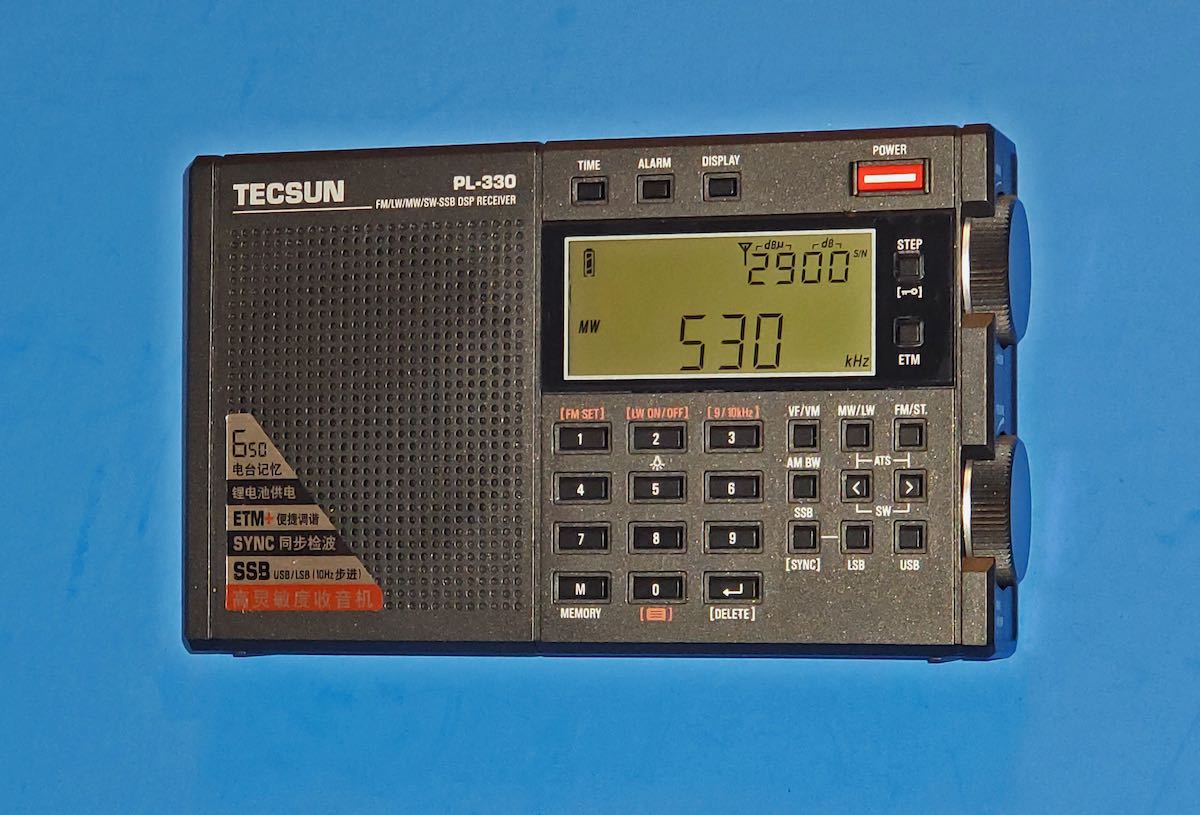 Tecsun has succeeded in its primary objective of adding SSB capability to an Ultralight-sized model at a breakthrough price, and for hobbyists primarily desiring this one capability the PL-330 will not disappoint. Once the SSB tuning system is mastered the model is capable of matching the D-808 and Skywave SSB’s performance in this one aspect, but in all other aspects (except Shortwave sensitivity) the model’s design is somewhat disappointing. Limited DSP filtering reduces the model’s appeal to MW split-frequency DXers, and the relatively long loopstick is an underperformer, delivering modest MW sensitivity. FM performance is also run of the mill, and the Synch detector is next to useless. Although my three test models had good quality control the lack of any company warranty does not inspire confidence, and since all of these models are currently shipped from overseas it is imperative to purchase from a reliable vendor with an excellent track record. The 26-page Chinese manual is next to useless for an English speaker, so every effort should be made to secure the 27-page English manual as an essential part of the purchase. With this manual as a guide the purchaser can expect to learn the radio’s functions and master the SSB tuning system, but in the PL-330 this one major advantage is unlikely to convince the purchaser that this model is a classic DXing breakthrough
Tecsun has succeeded in its primary objective of adding SSB capability to an Ultralight-sized model at a breakthrough price, and for hobbyists primarily desiring this one capability the PL-330 will not disappoint. Once the SSB tuning system is mastered the model is capable of matching the D-808 and Skywave SSB’s performance in this one aspect, but in all other aspects (except Shortwave sensitivity) the model’s design is somewhat disappointing. Limited DSP filtering reduces the model’s appeal to MW split-frequency DXers, and the relatively long loopstick is an underperformer, delivering modest MW sensitivity. FM performance is also run of the mill, and the Synch detector is next to useless. Although my three test models had good quality control the lack of any company warranty does not inspire confidence, and since all of these models are currently shipped from overseas it is imperative to purchase from a reliable vendor with an excellent track record. The 26-page Chinese manual is next to useless for an English speaker, so every effort should be made to secure the 27-page English manual as an essential part of the purchase. With this manual as a guide the purchaser can expect to learn the radio’s functions and master the SSB tuning system, but in the PL-330 this one major advantage is unlikely to convince the purchaser that this model is a classic DXing breakthrough
TECSUN PL-380
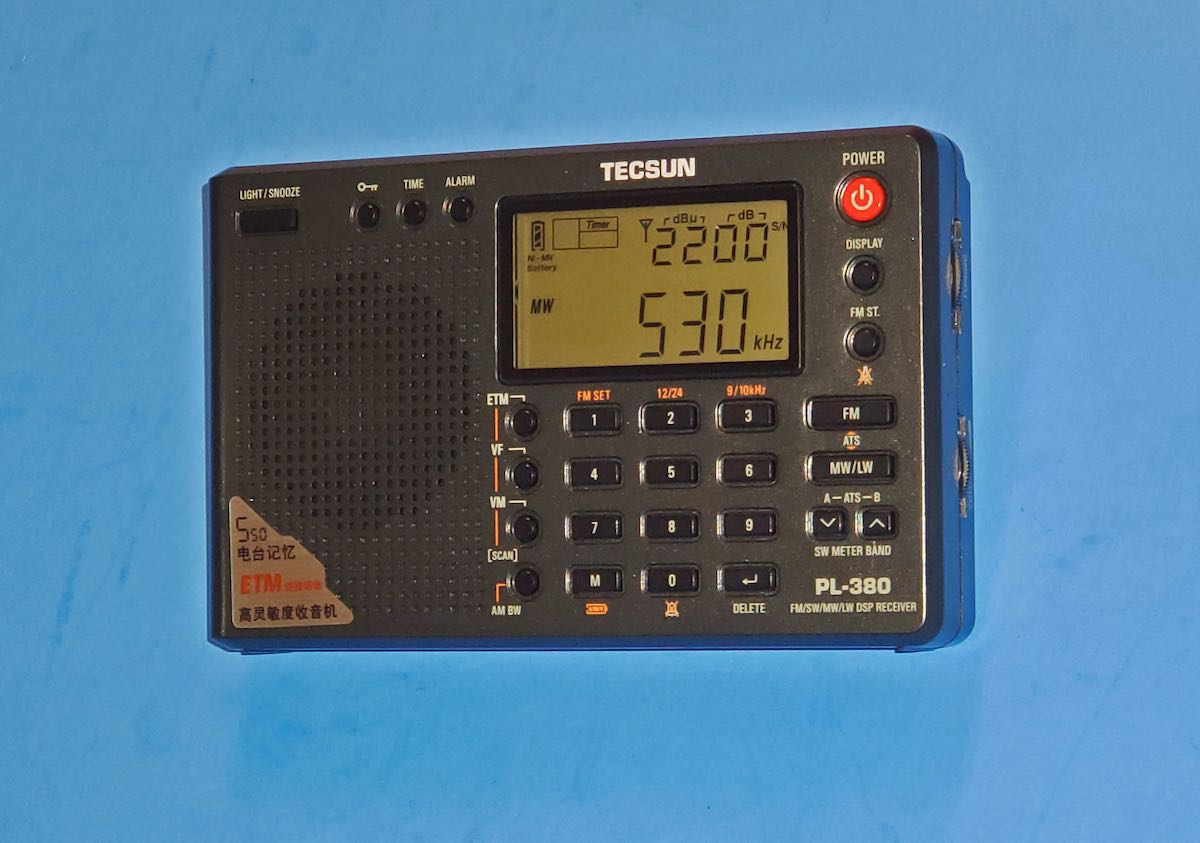 The PL-380 was an innovative, breakthrough model when first introduced in 2009, but Tecsun has shown no interest in improving its capabilities since then. When sales were good Tecsun decided to increase its profits by eliminating the DSP chip shielding– which pretty much reveals their overall attitude toward this model. If you desire innovative breakthroughs, look elsewhere. The performance of the Si4734 DSP chip and powerful audio amp still make the radio a competitive, low cost performer in MW-DXing, though, so long as you don’t mind the internally-generated heterodynes and other quirks. For the FM and Shortwave frequencies its performance has clearly been edged out by the innovative R-108 and PL-330 models respectively, but as part of a bargain package the performance on these two bands is acceptable, if not overly exciting. The radio has a fairly good quality control record, and lends itself to relatively easy loopstick transplants and other modifications. Whereas Tecsun will probably continue to offer this 2009-design radio for as long as they can make some profit, DXers will probably continue to purchase it as long as it seems like a bargain. If you can tolerate the rough edges and concentrate on MW-DXing, that would still be a reasonable trade—even in the 2021 radio market.
The PL-380 was an innovative, breakthrough model when first introduced in 2009, but Tecsun has shown no interest in improving its capabilities since then. When sales were good Tecsun decided to increase its profits by eliminating the DSP chip shielding– which pretty much reveals their overall attitude toward this model. If you desire innovative breakthroughs, look elsewhere. The performance of the Si4734 DSP chip and powerful audio amp still make the radio a competitive, low cost performer in MW-DXing, though, so long as you don’t mind the internally-generated heterodynes and other quirks. For the FM and Shortwave frequencies its performance has clearly been edged out by the innovative R-108 and PL-330 models respectively, but as part of a bargain package the performance on these two bands is acceptable, if not overly exciting. The radio has a fairly good quality control record, and lends itself to relatively easy loopstick transplants and other modifications. Whereas Tecsun will probably continue to offer this 2009-design radio for as long as they can make some profit, DXers will probably continue to purchase it as long as it seems like a bargain. If you can tolerate the rough edges and concentrate on MW-DXing, that would still be a reasonable trade—even in the 2021 radio market.
Summary
Now that you have the most detailed Ultralight radio purchasing guide on the planet, why not take the plunge, and invest some minor pocket change in one of these innovative pocket radios? Whether for serious DXing or for travel reception, these new models provide amazing capabilities far beyond the humble pocket radios of the last century. If you grew up as a teenager with such a transistor radio introducing you to the thrills of DX, you will discover that the thrills of DX have taken a quantum leap with these astonishing new models. Especially during a pandemic with added challenges, enjoying the simple pleasures of DXing with a simple radio is an excellent way to leave the stress behind.
So go ahead and make your choice—and discover the unique thrills of chasing rare DX with a highly advanced pocket radio. The 1,500+ member Ultralight Radio Group waits to welcome you, and provide you with all the assistance you need in providing a major boost in your hobby satisfaction!
73 and Good DX,
Gary DeBock (in Puyallup, WA, USA)

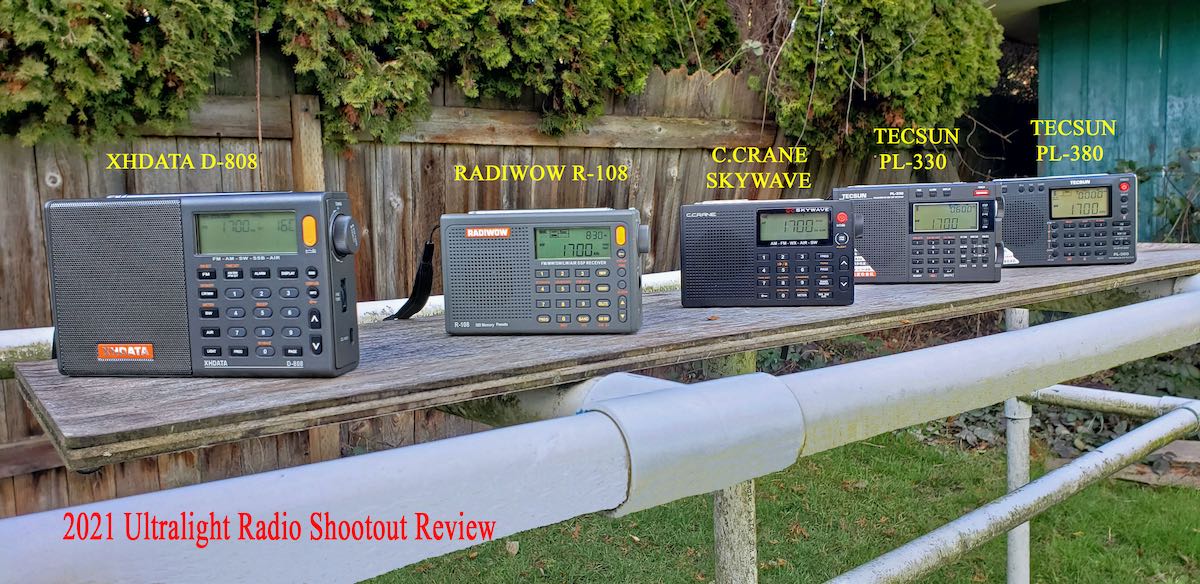
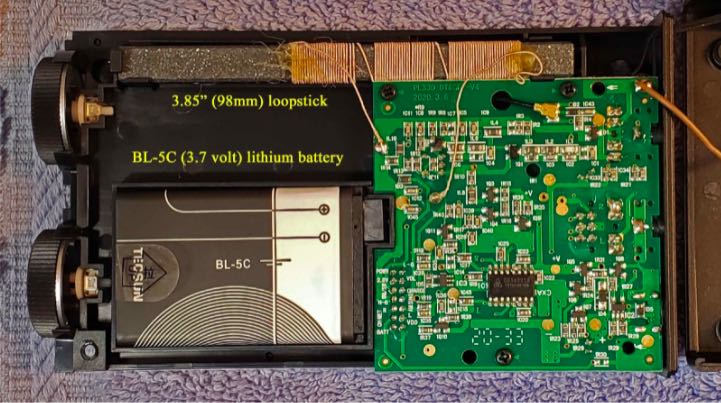
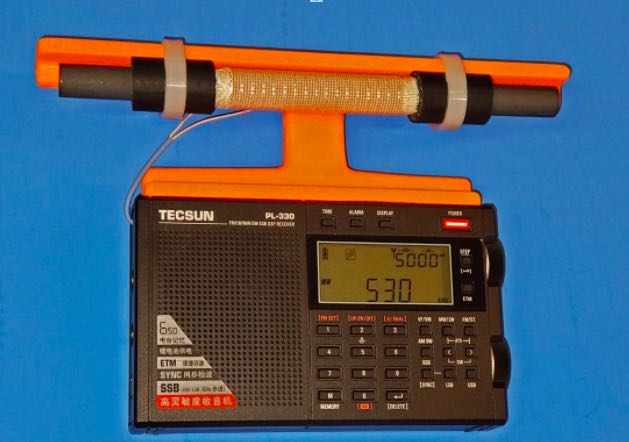
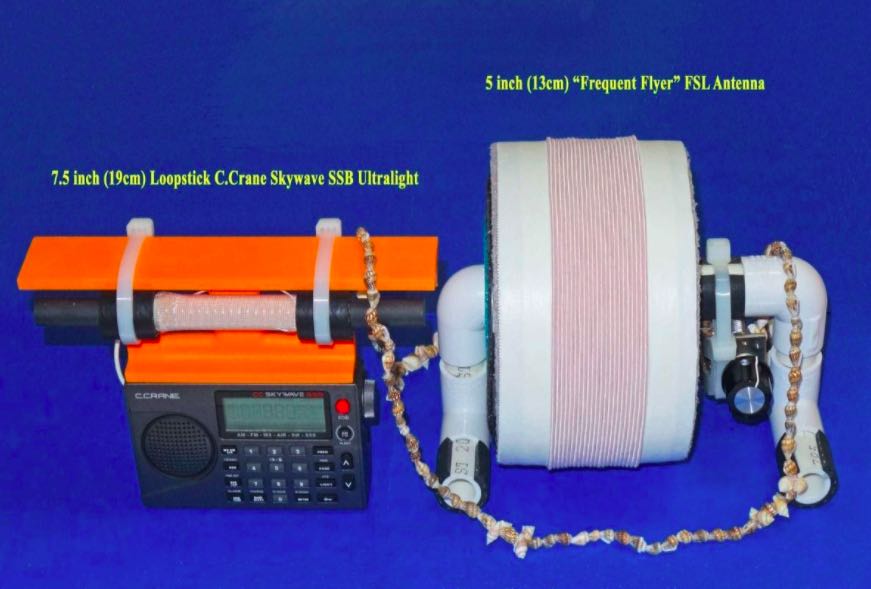
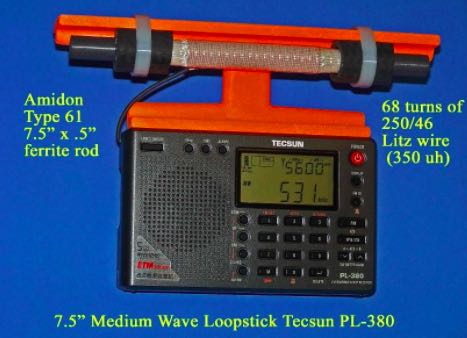
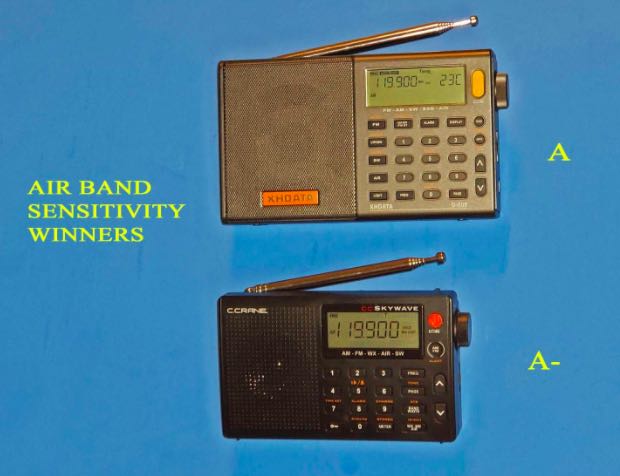
hi,
thank you for your blog!
I found and find it very very handy!
I am blind, so I am sure you can emagen how important I find radio.
I own the tecsun pl10et and it’s fm sensativity is top notch, I bort it in 2018 roughly,
sadly, here in the uk, mediam wave is closeing down, stations are lieveing the am band.
this makes me very sad.
the meet of my email and a question,
which portable has the best in fm reception sensativity are there better kanditates compared to my pl10ET and pl10 with the same form factor as the pl10 and pl10et?
and the radio is the same size?
to put it in perspective from a uk base,
on a regular fm radio, I can just very very faintly get 104.5 fm bbc three counties radio which broadcasts from bo brickhill which is in milten keens
I live in coventry
holbrooks, 63 miles away.
on the same frequency I can also get bbc radio derby which broadcasts from drumb hill
53.5 miles away from my location.
when using my tecsun pl10et, I can get both stations with cristel clear quality.
if i turn one way, I can get bbc three counties radio and I turn another way I can get bbc radio derby on the same frequency.
the pl10ET takes 3 aa batteries.
I love the frequency input, it’s very accessible for someone like me whome can’t see.
I just wish that the light functionallity could be completely turned off, for one, I can’t see so any light is just a power draw,
and having the display off completely may improve reception of all bands due to less electronics usage?
Thank you for swling!
Majid Hussain
Coventry
UK
the ticking noise in radiwow r-108 is due to the dsp chip named 4734D5OGU which is not made by Silicon Labs (SILABS), but a Chinese DSP manufacturer probably the XHDATA Company? However trying to apply the 10uF capacitor on the Radiwow R-108’s BL5C battery terminal and putting an aluminum foil on the DSP chip/integrated circuit chip or applying the modified silicone conformal coating and nickel conductive plate on the DSP chip/Integrated Circuit chip will likely remove this annoying tick and of course decouple it to reduce electromagnetic interference. Similar to Retekess V115, Radiwow/Sihuadon use BL5C battery
Link here: https://www.youtube.com/watch?v=sXj7fKoK1lA
My modification of Sihuadon R-108:
EMI reduction – aluminum foil shielding in PCB and 10uF capacitor in BL-5C battery terminal
Bass booster – 1000 uF 25 volt capacitor connected in positive and negative side in the speaker (paralleled) (since Sihuadon/Radiwow R108 speaker is 5W 8ohm speaker) totalling 500uF capacitance.
In addition, the wire connected to antenna inside has aluminum foil shielding to reduce noise
Hi Gary
Because i cannot get any info from Ebay users for the original xhdata d-808.
Besides the mini-usb and plastic feet, is it safe to say the original had the temperature displayed on the top right?
(Or did the 2021/2022 have the temp also on the top right?)
I know the 2023 has the time display
Garry,
An amazing review! If I hadn’t already just returned my D-808 back to Amazon AU, because of rather noisy headphone output at low volume levels, in combination with the dredded muting while tuning, I’d be seriously reconsidering and keeping it. I found on FM and MW, alongside my larger tecsun PL880, it does an impressive job of holding its own!
Overall, it seems like the 808 is the best performer, but now I’m seriously considering importing a CC skywave SSB, and sacrificing some FM and MW performance, in exchange for quality reassurance, and knowing that shipping between AU and the US is reliable. Also, I can’t pass up the impressive 70-hour runtime on 2 AA’s!
Oops. Gary! Check typing/spelling before posting…
Love these articles! Since the loss of “Passport to World Band Radio” and their excellent receiver reviews, Gary’s shoot-outs have been the undisputed authority on ultralight radios. The 2015 version convinced me to purchase the Skywave and I’ve since added most of the others from that article to my arsenal.
When I first saw the Radiwow receiver, I was ready… until I read Jay Allen’s article describing the “inspiration” from C Crane’s intellectual property. And while it may have been only 50 bucks, I decided to invest it elsewhere – some C Crane headphones!
Is there anyway to contact Gary, i would really appreciate it if anyone can help.thank you.earl tasca Warwick ri
Fantastic evaluation and comparisons Gary, thanks for your work. I have some suggestions that make the Tecsun PL-330 perform better.
I found two ways to greatly reduce the soft mute. 1. Tune off frequency 1KHz or if you have to 2 KHz and if no sideband interference try each side of the frequency and this generally works well. I have to increase the volume and sometimes adjust the bandwidth. 2. Use SYNC and try each sideband but the experience is quite variable due to inadequate lock on difficult signals (see below).
My Tecsun BL-5C battery gives a lot of listening but I also bought a 2450mAH version and a charger. If I really want to power it from AA batteries I have an external box taking 4 batteries that has the required USB lead.
The annoyingly low STEP button surface can be raised by a) painting it, repeatedly if desired) b) gluing a plastic shape on top of it. I do understand the reason it is recessed because it it doubles as the keyboard LOCK key but the battery is so small and thin I would rather just take it out and put it in a little plastic container for travelling.
The AM bandwidth choices are useful but basic (down to 2.5) but when put in SYNC the SSB bandwidths of 0.5 1.2 2.2 3 & 4 become available along with tuning to the upper or lower sideband (even on MW) I like the control up and down the bandwidth choices with the volume control which enables retrying two or three until satisfied.
The SYNC is not very stable but by playing around with the frequency adjustment in 10 or 1Hz and if necessary doing the frequency alignment procedure (zero beat in SSB mode and hold down the LSB key) a sync can be stabilised or be made tolerable. When I tune to another station it seems best to exit sync mode, tune and then enter SYNC again.
My receiver (firmware 3305) seems to overload easily and to use an external antenna I wound a short piece of insulated stiff wire 8-10 turns around the telescopic and connect the antenna to that. By moving the windings up to a short extended section I can reduce the overloading. At the bottom section there is plenty of signal for the weakest stations.
The “less than” and “greater than” keys are terrific. They move frequency to the next band, to the station previously tuned in that band which can be very handy to monitor a SW station on different meter bands or just to return to a previously tuned station on mine.
At first I was dismayed by the soft mute of this radio and the poor sync lock, but with some experience I have circumvented most of the issues. Overall I rate it much higher than my PL-380 and much more fun to use. Its very sensitive on shortwave but also good on MW in my location especially when I use the telescopic as the antenna (hold down the 3 key).
The Chinese are great at copying everything except intellectual property ethics.
While I won’t reward them with my money, it’s a well presented review, thank you!
Yes, it’s interesting how much the current Chinese attitude towards IP parallels that of the US in the late 19th / early 20th centuries, isn’t it? 😉
No, not really. The US invented a ton of things during that era but widespread IP pirating wasn’t a significant part of that.
See
https://www.history.com/news/industrial-revolution-spies-europe
It’s called the Belka DX…/I had to look it up.
There is a company (Russian I think) making a tiny HF receiver that’s about the size of a pack of cigarettes. I has SSB, AM, and a CW mode. So small it doesn’t have have a speaker, but it there is a speaker option that makes it a bit bigger. I don’t think it has an FM or AM band which could limit it’s use. But if your needing a QRP receiver it would be great. I saw it on a ham radio focused youtube video. Sorry but I forget the product name and video name… But it is very small. I’m sure someone knows the video/radio I’m talking about.
There are some excellent articles on swling regarding the Belka DSP/DX. I have one and it really is a cut above any other portable I’ve used on shortwave.
I thought the point of “ultralight” was to take a low end receiver and see how many stations you could hear. A new challenge to renew oneself after using top end equipment (and less challenge).
The parallel would be the interest in QRP in ham radio fifty years ago, “anyone can work the world with a kilowatt, let’s try it with simpler equipment”.
These radios all seem out of range, the type of radio used every day.
Superb review, as usual, the kind of work you would expect from Gary DeBock.
Hat tip to Gary for writing and Thomas for publishing.